

What is a Cruise Ship?
A cruise ship is a luxury vessel that is used to take passengers on a pleasure voyage in a journey that is as much a part of the experience as the various destinations on the way.
In contrast to an ocean liner that transports passengers from one point on the globe to the other often across the oceans, a cruise ship or a cruise liner as it is known by most, takes the people on board to a round trip that is of varied duration, from a single day to possibly a week and culminates at the originating port.
This is a very refreshing mode of enjoyment and recreation, which relaxes the mind and replenishes energies to a great extent.
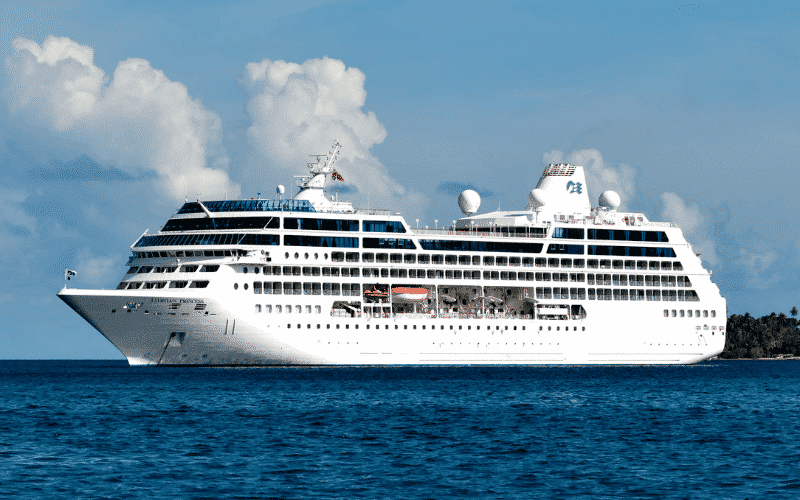
History of Cruise Ships
The present-day form of cruising can be traced back to the beginning of the twentieth century when transoceanic travelling was at its zenith.
The only mode of transport was the ships so the different companies that were in this business offered the best services to compete in the market.
These ocean liners with luxurious services offered what came to be known as line voyages. But because of the long journey, which at best would be no less than four days, there had to be huge storage for fuel and other necessities and that didn’t leave much room for luxuries.
With the advent of jet aeroplanes in the latter half of the last century, there was a shift in passenger preference and the long sea voyages were left for only the ardent sea fans.
Related Reading:
- How Are Cruise Ships Powered?
- How Do Cruise Ships Get Fresh Water?
The Advent of Cruise Ships
This situation was ideal for the launch of a cruise ship. It needed something strikingly different and exciting to bring back the interest of the people to sea voyages and this is where these trips gained popularity.
Considering the fact that the journey is relatively short with many stoppages at exotic locations, the ships are designed accordingly, thereby making more room and utilizing that space for an open design that exudes extravagance. It would be appropriate to liken a cruise ship to a floating hotel complete with a hospitality unit amongst other crew members.
Facilities on Cruise Ships
The facilities onboard these cruise liners include great dining services. Some liners offer open-air dining on the deck, whereas, there are others that have expensively designed dining halls with mouth-watering recipes to leave a long-lasting impression on the passengers.
In addition to this, there are casinos, fitness centres, spas, cinemas, and some ships even have a Broadway-like theatre. These cruise ships also boast swimming pools, hot tubs, lounges, libraries, gyms and clubs.
To put it in a nutshell, they pamper the passengers with the best of hospitality and services that can be imagined with some of the choicest natural views along the sea.
Over the last decade, cruising has become an integral part of the tourism industry contributing over $25 billion yearly to this booming sector. The major bulk of the business as expected comes from the North American and European regions but the other areas like the pan pacific are also catching up.
You might also like to read:
- Top 10 Largest Cruise Ships in 2021
- Top 10 Most Expensive Cruise Ships in 2021
- Engineering Department Onboard Cruise Ships – A Detailed Guide
- Titanic vs Modern Cruise Ship: How Ships Have Evolved
- Video: Why Are Cruise Ships White?
Disclaimer: The authors’ views expressed in this article do not necessarily reflect the views of Marine Insight. Data and charts, if used, in the article have been sourced from available information and have not been authenticated by any statutory authority. The author and Marine Insight do not claim it to be accurate nor accept any responsibility for the same. The views constitute only the opinions and do not constitute any guidelines or recommendation on any course of action to be followed by the reader.
The article or images cannot be reproduced, copied, shared or used in any form without the permission of the author and Marine Insight.
Do you have info to share with us ? Suggest a correction
Latest Type Of Ship s Articles You Would Like :
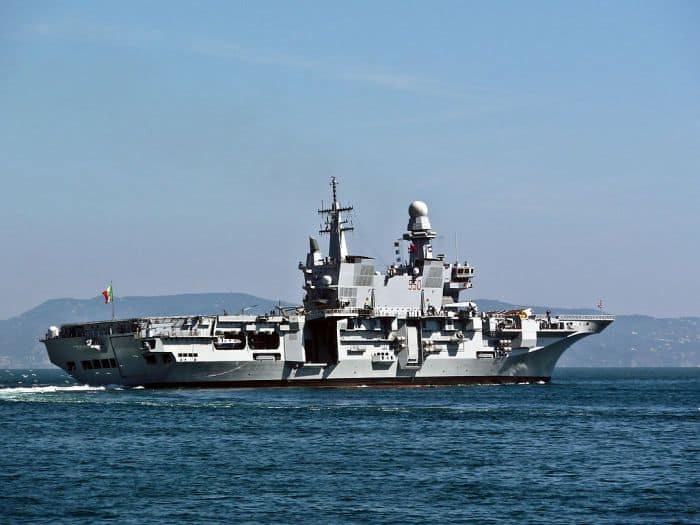
Top 15 Biggest Aircraft Carriers in the World
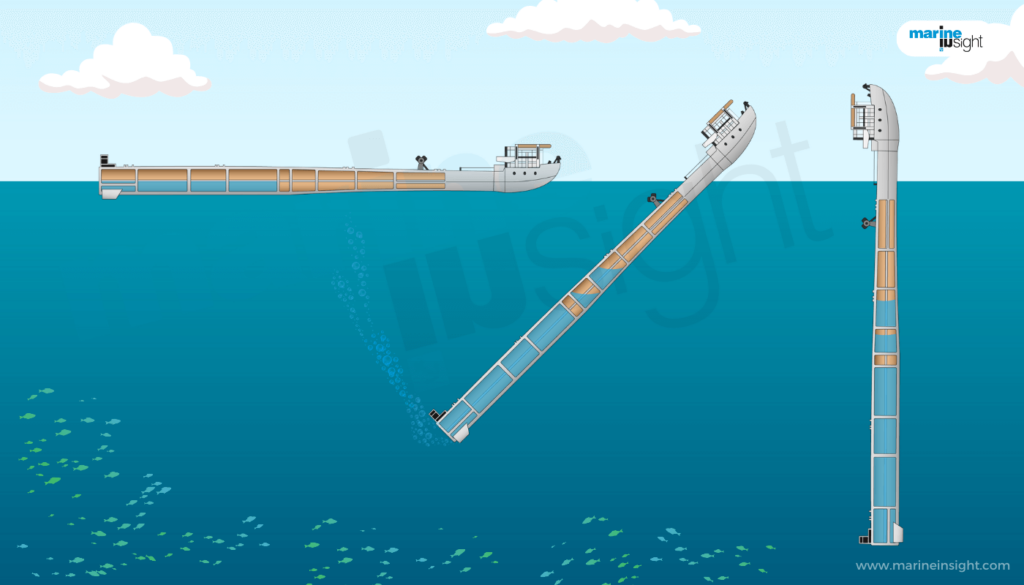
What is Floating Instrument Platform?

5 Fastest Submarines in the World
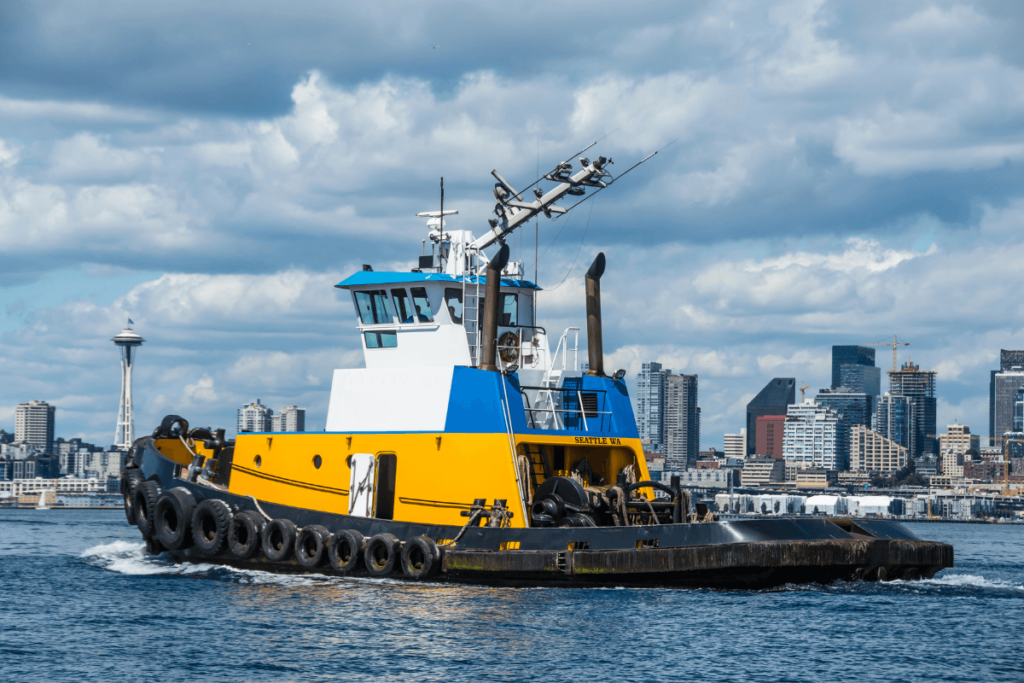
The Ultimate Guide to Tug Boats: Types, Functions, and Applications

Frigates vs Corvettes: What are the Differences?
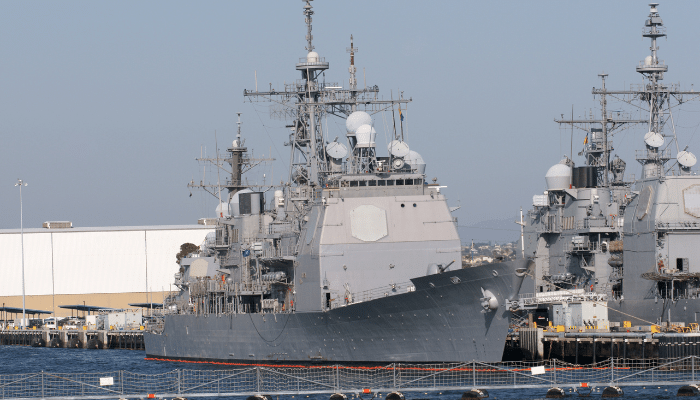
Cruisers vs Destroyers: What are the Differences?
About author.
Marine Insight News Network is a premier source for up-to-date, comprehensive, and insightful coverage of the maritime industry. Dedicated to offering the latest news, trends, and analyses in shipping, marine technology, regulations, and global maritime affairs, Marine Insight News Network prides itself on delivering accurate, engaging, and relevant information.
Subscribe To Our Newsletters
By subscribing, you agree to our Privacy Policy and may receive occasional deal communications; you can unsubscribe anytime.
Leave a Reply
Your email address will not be published. Required fields are marked *
Subscribe to Marine Insight Daily Newsletter
" * " indicates required fields
Marine Engineering
Marine Engine Air Compressor Marine Boiler Oily Water Separator Marine Electrical Ship Generator Ship Stabilizer
Nautical Science
Mooring Bridge Watchkeeping Ship Manoeuvring Nautical Charts Anchoring Nautical Equipment Shipboard Guidelines
Explore
Free Maritime eBooks Premium Maritime eBooks Marine Safety Financial Planning Marine Careers Maritime Law Ship Dry Dock
Shipping News Maritime Reports Videos Maritime Piracy Offshore Safety Of Life At Sea (SOLAS) MARPOL
- Skip to primary navigation
- Skip to main content
- Skip to primary sidebar

Travel Codex
Your Resource for Better Travel
The Beginner’s Guide to Cruises
Beginner’s Guide to Cruises – Choosing the Right Cruise Line
First, which cruise line should you choose? There’s many cruise lines out there, and you’ve likely seen many a catchy tagline on TV ads. I usually like to differentiate the cruise lines in the following categories. Note that I’m excluding river cruises from this post. Those provide an entirely different experience from traditional cruise ships. To try it yourself, consider reading this post with 6 TIPS FOR YOUR NEXT WESTERN CARIBBEAN CRUISE .
Budget Mass Market – these are your big cruise ships with a lower price point, and generally advertise to a younger clientele. You do get your standard cruise ship amenities, like the endless buffet line. Many also have “gimmick” features designed to attract younger cruisers and families, like Royal Caribbean’s artificial rock climbing wall. Staterooms are usually smaller, with a lower standard of amenities. Cruise lines in this category: Carnival, Costa, Norwegian, Royal Caribbean.
Upscale Mass Market – these ships are slightly smaller, though “small” means 2,000-3,000 passengers. Prices run a little higher than the budget lines, though the trade-off is a more luxurious ship and more personalized service. These cruises also target an older demographic. Cruise lines in this category: Celebrity, Cunard, Holland America, MSC, Princess.
Luxury All-Inclusive – if you’ve cruised before, you might have received brochures from a “luxury” cruise line. At first blush, the prices might give you a little sticker shock. They are often several times the price of a mass market ship. But, the ships are substantially smaller, and typically are all-inclusive. In other words, no upcharges for things like specialty dining, or for alcoholic beverages. Cruise lines in this category: Azamara, Crystal, Hapag-Loyd, Oceania, Paul Gauguin, Regent Seven Seas, Seabourn, Silversea, Viking Ocean Cruises, and Windstar.

I should also mention Disney Cruise Line, which doesn’t neatly fall into any of these categories. While certainly mass market, it’s the only cruiseline that actively markets to…well, families with kids. From what I gather, the mix of amenities and activities falls somewhere between budget and upscale; however, pricing runs much higher than the budget lines. Caribbean cruises from Port Canaveral, for example, typically run 2-3x higher on Disney compared to Royal Caribbean or Carnival.
So which to choose? It really boils down to your preference on ship size, and how much nickel-and-diming bugs you. In general, the more upscale the cruise line, the smaller the ship, and the more inclusive the fare. After trying out one of the mega-ships in 2017, I’m not really a fan. They’re too big and impersonal, and service tends to suffer. I personally think the 2,000-3,000 passenger ships provide a decent compromise. They feature plenty of amenities, yet are small enough to keep service reasonably personal. Get More Information here for some reliable maritime lawyers who can help you if ever you get injured in a cruise ship!
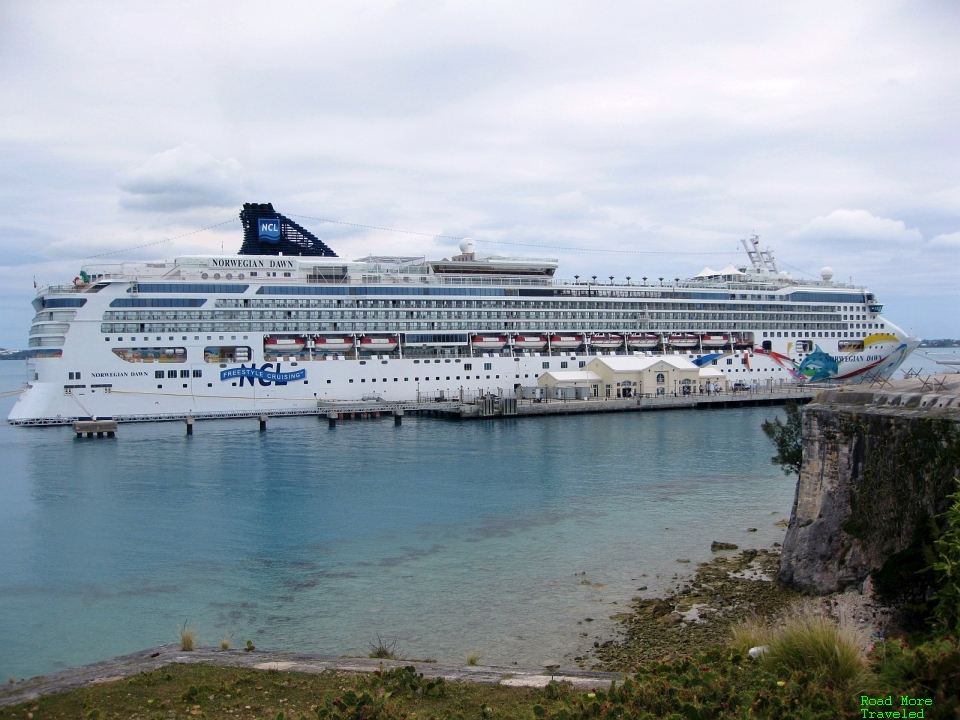
Beginner’s Guide to Cruises – Choosing Cruise Destination and Length
The cruise lines literally run the gamut when it comes to both cruise length and destination. Most of the major lines serve the same destinations, which is to say, pretty much everywhere. Cruises to the Caribbean, Alaska, and Mexico probably attract most of the attention and advertising here in the states. But there are plenty of other worldwide itineraries out there, including:
- Trans Panama-Canal, usually California or Florida to South America
- Europe, Baltics, and Russia
- Mediterranean, both western and eastern
- Transatlantic crossings
- Northeastern US and Canada
- US/Canadian West Coast
- Hawai’i
- Japan, Korea, Southeast Asia, and India
- Australia and New Zealand
Some of your specialty cruise lines hit more “exotic” destinations like Antarctica and Greenland. But prepare to pay a pretty penny for the privilege. Note that many ships operate “back to back” cruises covering multiple itineraries. For example, the same ship might cruise from Istanbul to Rome, then Rome to Barcelona. You can book both cruises if you wish. Pricing varies, however; sometimes, it’s additive (i.e. you pay for two separate cruises). Other times, the cruise line might sell it as one single cruise with some discount off the combined price. You typically see this with longer inter-continental itineraries.
When it comes to picking an itinerary, keep in mind, a cruise lets you have a taste of multiple destinations. But with usually only a single day (typically 8 am – 5 pm) in port, you’re not going to be able to do a whole lot. You usually have time for one shore excursion. Or maybe a couple of tourist sites if you explore yourself. My general advice: cruises make ideal trips if you want to try out a destination, but don’t want to commit to a longer stay. The exception – “expedition” cruises, which focus on a specific area for several days. Bermuda cruises, meanwhile, often give you one full and two half days in the island nation.
As for cruise length, cruises range from 3 days to as much as 150 (yes, really) days. My advice here really applies more to cruise newbies. You’re either going to love cruising, or hate it. There really is no middle ground. For first timers, I usually suggest starting out with a short cruise; for example, a 3-night Caribbean cruise from Florida to the Bahamas. If you love it, great, go with a longer one next time. If you hate it, well, you’re only on the ship for a couple of days.
Honestly, as a veteran of several cruises, I don’t care for the short cruises. 3 nights basically means you board, get settled, then pack up again just as you get comfortable. I personally prefer cruises of 7-10 nights. That gives you enough time to unwind and enjoy the ship, but it’s not so long that you get bored.

Beginner’s Guide to Cruises – Choosing the Right Stateroom
Once you select an itinerary, now comes the fun part – selecting a stateroom. As a general rule, cruise ships offer the following stateroom categories:
- Interior – these rooms typically comprise the smallest rooms on the ship, and have no window. They’re also the cheapest.
- Oceanview – slightly larger rooms with either a porthole or floor-to-ceiling window facing the sea.
- Oceanview with Balcony – standard oceanview room with a small exterior balcony.
- Mini-suite – basically a larger version of the oceanview with balcony. Some include additional amenities like bathtubs, priority boarding/disembarkation, dining reservations, etc. Most mini-suites occupy the higher decks of the ship, allowing for better views from the balcony.
- Suites – the largest and most luxurious rooms on the ship. Besides tons of space, suites typically include butler service, exclusive lounge access, an exclusive concierge, etc. Like mini-suites, suites typically occupy the higher decks of the ship.
Some cruise lines also offer “concierge class” staterooms. Think of these like club level rooms at hotels. Major benefits include a stateroom on a dedicated floor, a dedicated dining room (often with a special menu), and access to a dedicated concierge for shipboard and shore activities.
Obviously, what you choose depends on your travel budget. But in general, my suggestion is, if you have the means, go for a room with a balcony. One of my favorite things to do when cruising is to head out on the balcony when arriving or departing a port and take in the views. Or to enjoy the sunset with a cup of tea. Yes, you can do any of those things up on the pool deck. But I find something special about doing that in the peace and quiet of my own balcony. If you’re cruising to Alaska or through the Panama Canal, definitely pay extra for the balcony. It’s dog eat dog when it comes to securing real estate for the view of the glaciers or the canal crossing. You’ll appreciate every penny you spent for the guaranteed view.

That being said, as reader “coasttal123” notes below, think about how much time you plan to spend in your stateroom. With a small child in tow, the extra room from a balcony or mini-suite comes in handy. On the other hand, if you plan to spend all your time on shore excursions, or at the pool, bar, shopping arcade, etc., perhaps saving money with an interior stateroom makes more sense.
Also note that location within the ship can make a difference. Your best views are midship; you receive better pricing at the forward and aft (rear) of the ship. Some staterooms at the aft end face the rear, providing you a beautiful view of the ship’s wake . You generally feel less vibration on higher decks, but if you get seasick, there’s less motion on the lower decks (midship also helps in this regard). Also keep in mind proximity to elevators and stairs, and major ship amenities such as dining rooms. All cruise lines provide deck plans, so I suggest reviewing that before selecting a specific stateroom. You probably don’t want a stateroom right above or below the disco, for example, if noise disturbs your sleep. On the other hand, a room near the stairs leading to the dining room saves time at dinner.

Booking Direct vs. Booking via Travel Agent
Like other modes of travel, most cruise lines allow you to book direct or via a travel agent. Unlike airlines or hotels, though, booking through a travel agent often yields a better deal. Why? Travel agents sometimes have access to additional discounts or onboard credits. An “onboard credit” is basically like an airline voucher, which you can use to cover onboard purchases. For example, I often use cruise.com to book, and they sometimes offer me an extra $50 of funny money as a repeat customer. Not much, but usually enough to cover most of a soda package for a 7-night cruise. I recommend checking both the cruise line website and a travel agent to see who offers the better overall package.
Also, I’ll discuss this more in a future post, but if you have the Amex Plat, you have access to the Cruise Privileges Program . This provides some additional discounts and goodies, through a select number of major cruise lines.
Either way, you can usually select a specific stateroom at the time of booking. Or, if you want to take a chance, you can book a “guarantee” cabin. This means you’re guaranteed to receive a cabin of a certain category, such as an oceanview with balcony. You don’t get to pick a particular room, though. But you could hit the jackpot and receive an upgrade to a higher category.
If you book through an agent, like the airlines, you can manage your reservation at the cruise line website. This allows you to select dining times, book shore excursions, etc. If you want to change or cancel, though, you must contact the agent if you book through one.
Finally, most cruise lines offer “future cruise promotions” if you book another cruise while still on board. Sometimes the promotion is a discount off the rack rate; other times, it’s onboard credits or reduced rates on beverage/specialy dining packages. If you find yourself enjoying your cruise, might as well stop by and see what the offers are. Typically you only have to put down a nominal deposit. And often, the cruise line lets you put down an “open” deposit, good for 2-4 years, and you can take advantage of the promotional offer as long as you book during that time.
Dining and Beverage Charges
Unfortunately, except for high-end cruises, cruise ships charge extra for a whole lot of stuff. Your basic cruise fare includes the stateroom, “standard” dining, and most shipboard activities and entertainment. You pay extra for shore excursions, soft drinks, alcohol, specialty dining, and certain activities like wine tastings. (Luxury cruise lines often include at least some alcohol in the base fare.) Among mass market lines, Disney is one notable exception as it includes soft drinks for free.
Now, you can defray the cost of upcharges somewhat. First, both the cruise lines and travel agents run constant promotions offering onboard credits. Generally, the higher category stateroom you reserve, the more credit you receive. Second, if you plan to drink a lot of alcohol and/or soda, consider buying a beverage package. Princess, for example, offers unlimited sodas, juice, and mocktails for $9.99 per person/per day. Or, move up to a package that adds espresso drinks for $19.99/person/day. Or go all-out with beer, wine, and cocktails up to $12/serving for $59.99/person/day.
Think carefully about how much you actually plan to use the benefits before buying, though. Last time I cruised with Princess in 2015, sodas cost $2.50 each. Wine, beer, and cocktails averaged about $8 each. Let’s assume you decide to buy the soda package. You’d need to order 4 or more sodas per day to break even. Do the math and make sure it makes sense for you. Note that technically, a beverage package is specific to the person who buys it. In other words, 3 people sharing a stateroom can’t share a single beverage package. In practice, over 9 cruises, I’ve found that wait staff don’t enforce this. When both my wife and I order sodas, they look at my soda sticker and don’t charge for either one. But your mileage may vary.
Important note: bringing aboard your own alcohol is strictly verboten. Ship security will find it, and hold it until the last day of the cruise. (Ditto for any liquor you buy in port.) You can, however, bring your own bottled water; I recommend bringing a bottle or two. The ship usually charges $3-4 a bottle. Once you reach your first port, you can buy some at a supermarket for a fraction of the cost.
Fixed vs. Specialty Dining
Meanwhile, when it comes to dining, there’s two things to consider. First is deciding between “fixed time” dining, or “anytime” dining. Fixed dining simply means you eat dinner in the main dining room at the same time each night. Typically, this means a choice of a 5:30 pm or an 8 pm seating. “Anytime” means you can show up for dinner at any point during dinner service, usually 5-10 pm. (Breakfast and lunch are always on an anytime basis.) With fixed dining, you receive the same table with the same seatmates at the same time, every day; with anytime dining, you may have to wait in line for a table, and may not sit with the same people.
Note that you usually can request either a separate table for your party, or a shared one with others. If you choose anytime dining, you can call to reserve a table earlier in the day. If you don’t, you have to wait in line; you can usually get seated quicker if you agree to share a table. Also note that Norwegian completely eliminated fixed dining several years ago. The “Freestyle” concept includes anytime dining for all cruisers.
So which is better? If you have a large party and/or just don’t like waiting in line or making reservations, go with anytime dining. Personally, I prefer fixed dining. Traveling with the family, the security of the same table each day without a wait comes in handy. Having tried both, I also think the wait staff performs more personalized service with fixed dining. They get to know your preferences, and are usually better at handling special meal requests. On the other hand, if you like partaking in evening shipboard activities, fixed dining gives you less flexibility. Of course, you always have the fallback of the buffet, or specialty dining, discussed below.
“Specialty dining” is a fairly new concept, mostly applicable to mass market cruises. This can be a steakhouse, a health-conscious offering, sushi, etc. (See here for Princess’ specialty restaurant lineup as an example.) Cost typically ranges from $20-50 per person; you do sometimes see fare sale promotions that offer one or two freebies per sailing. Unless you’re getting a freebie or using up some onboard credit, I’ve never really understood this concept. I’ve always gotten plenty of (good) food in the main dining room; I have noticed some reduction in quality and portion sizes since specialty dining became a thing, though. Personally I just don’t see the value in dropping an extra $40 for a steak. I’d rather spend that money in port.

Beginner’s Guide to Cruises – Shore Excursions
Unless you plan to spend all of your port time at the pool, shore excursions are probably the most important part of a cruise. You have three general options for planning time in port.
Book a Ship Operated Shore Excursion
The cruise lines themselves offer multiple shore excursions in each port; these range from a couple of hours for shopping to all-day adventures. When buying from the cruise line, you can apply onboard credits to the cost, which of course reduces your out-of-pocket cost. The ship is also guaranteed to wait for you in case the tour runs late for some reason. The downsides: they cost more, and these are typically large group tours of 40 ore more people. So as you can imagine, you don’t get much time at any one spot, and there’s little opportunity to customize.
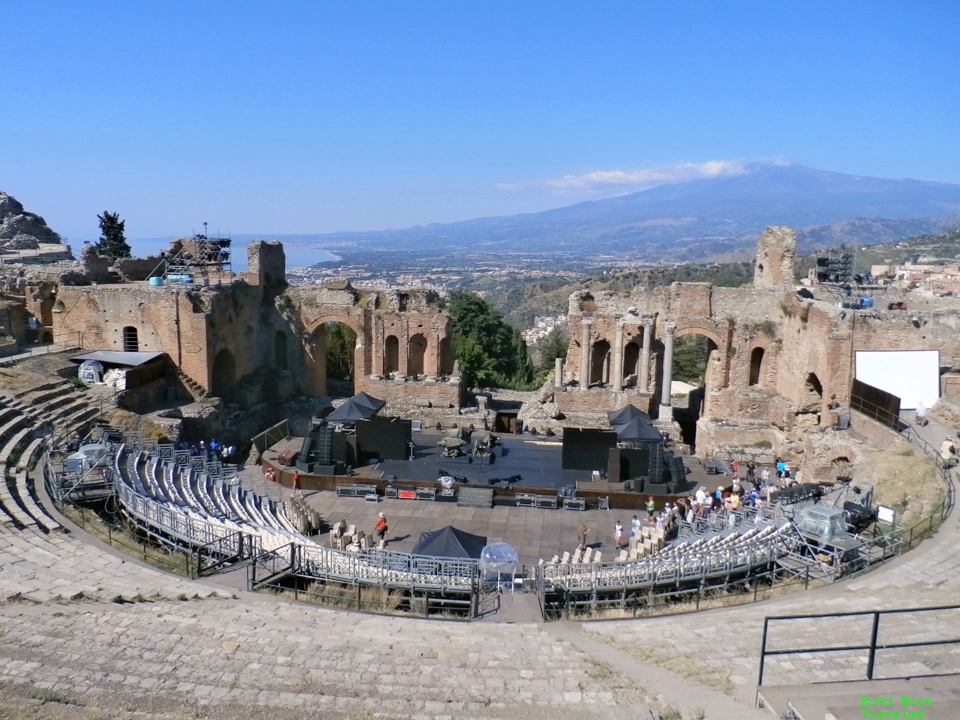
Book a Privately Operated Tour
In all larger cruise ship ports, private companies operate tours that compete with the cruise lines. These tours are sometimes cheaper, sometimes not, but are almost always much smaller groups. For example, I’ve booked a tour by ToursByLocals to the Andes in Chile , which included only our family. That gives you a lot of flexibility; the guide provides a suggestion, but you can customize it the way you want within reason. Another option – find the Cruise Critic Roll Call for your cruise ( example ) and either join a tour group, or try to create one of your own. Tour operators often offer discounts for groups larger than 4 or so. Or you can Google “shore excursions in [X]” and look up local operators in that port. (Here’s an example in Cartagena, Colombia.)
One downside to going private: you obviously can’t apply onboard credits. Additionally, if arriving at a “tender” port, those with private excursions receive last priority for a boat. That means it may take three or more hours just to get off the ship; that typically leaves you with very little time in port. Also, if you go with some local operators or join a Cruise Critic group, you might be stuck paying cash. Finally, remember that the ship will NOT wait for you if you’re running late. Make sure you thoroughly research the operator and pick only reliable guides.

Do It Yourself At the Dock
If you really like winging it, you can just try to hire someone at the dock. As you exit the ship, you’ll typically walk through a gauntlet of taxis and tour operators hawking their services. These can work out well. For example, after Royal Caribbean canceled our scheduled tour in Grand Cayman , mom found a booth selling island tours for $20 a person. And it ending up being a pretty good tour. Often times, you can negotiate a better price; this is especially true if you just want to hire a taxi to drive you around for the day.
Or if you really want to go cheap, you can just get off the ship and walk around the city. My wife and I actually had a nice time doing just this in Manta, Ecuador . The ceviche on the beach certainly was might nice.
The same warnings about private tours apply here. You’re probably going to have to pay cash, and the ship won’t wait for you if you’re late.

My recommendation: it’s generally easy to find reliable private tours these days. They might or might not save you money, but I’ve generally had better, more personalized experiences with them.
Booking Air Travel To and From Your Cruise
I’ll wrap up with a quick word on booking air travel to and from your cruise. All of the major cruise lines allow you to book flights through them. In the past, they just charged a fixed price, and assigned you whatever flights they wanted to. Now, though, it really just works like a third-party booking engine. You select your own flights, and pay the going published rate based on fare class. So why book through the cruise line? If you do, the cruise lines takes responsibility for any flight delays. They become responsible for getting you to the ship, even at the next port, if you misconnect. Otherwise, you’re on your own if you run late.
In general, I advise never never EVER book a flight to arrive the same day your cruise departs. Just don’t do it. I’ve read far too many horror stories of missed cruises due to flight delays. Instead, at a minimum, plan to arrive the night before, and spend a night in town. Many hotels in cruise ports, such as Port Canaveral, even offer cruise packages which include free transportation to the port the next day. If you absolutely must arrive the day of departure, book your flights through the cruise line. Or at least make sure you have travel insurance that will cover your cost to reach the next port.
Final Thoughts
I’ll cover some specific destinations like Alaska, and how to find the best deals on cruises, in future installments. In the meantime, hopefully this helps you select your perfect floating vacation!
Read This Next
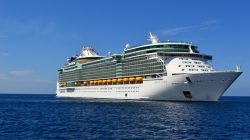
About Sriram Srinivasan
Sriram is an aficionado of all modes of travel, by land, air, and sea. A recovering frequent business traveler, he shows how to make the most of your vacation time, even without status.

- CruiseMapper
- Ships and Lines
Cruise Ship Design Construction Building
Information on cruise ship construction and design and how cruise ships are built. Learn what is the cost of building a cruise ship, where are cruise ships built, which are the major cruise shipbuilders/yards and building companies . Plus some other shipbuilding stuff and fun facts, like who built the Titanic ship, who built the most expensive cruise ship in the world, who built the most expensive yacht in the world, who is responsible for making the best cruise vessels of the world. This survey is integrated with our cruise ship engines-propulsion-fuel and cruise safety articles.

The actual cruise shipbuilding takes 2 to 3 years (the design plans are usually started a year ahead). Shipbuilding takes place in specialized facilities called shipyards. The cruise ship hull is designed by the shipyard, while the interiors and all the special features are designed by architects. Shipbuilders (also called shipwrights) do shipbuilding, as well as ship repairs, both services being also referred to as "naval engineering". The reverse process (dismantling of ships) is called ship breaking/demolition . The world's biggest ship-breaking scrap yards are in India (Alang) , Bangladesh (Chittagong) , Pakistan (Gadani) , and Turkey (Aliaga).
Cruise ship construction and design
The cruise shipbuilding process involves numerous complex research and testing procedures. The cruise ship design company (whose work is also called naval architecture) analyses and provides solutions to meet the Marine and Shipbuilding Industry's requirements, submitting the basic and detailed designs, ship equipment designs and production drawings to the shipbuilding company. The design firm also provides engineers with analysis, simulations, diagnosis, manufacture, repair and other data by using the latest CAE (Computer-Aided Engineering) technology. The ship cabins manufacturer is able to design and produce various types of ready-to-install ship cabins and bathrooms for virtually all passenger ships - big and small, luxury, ferries, Ro-Ros, research, etc. The shipbuilder also hires a company to provide the so-called "Lifecycle Services", pertaining mostly to the industry's rules and regulations. Some of these services are retrofitting and refurbishing and keeping regular updates regarding new rules and requirements.
It's a common modern practice big cruise ships to be built of pre-made huge sections. Entire multi-deck segments are built at another place, transported or slipway to the shipyard and lifted into place. The sections often feature even pre-installed equipment, cables, pipes, and other components - it saves a lot of shipbuilding time, and it surely saves lots of money. This technique was used for the first time in the construction of Cunard's Queen Mary 2 (2002-2004) by the French "Chantiers de l'Atlantique" company.
The next photo shows a pre-made section for the Symphony Of The Seas ship construction.
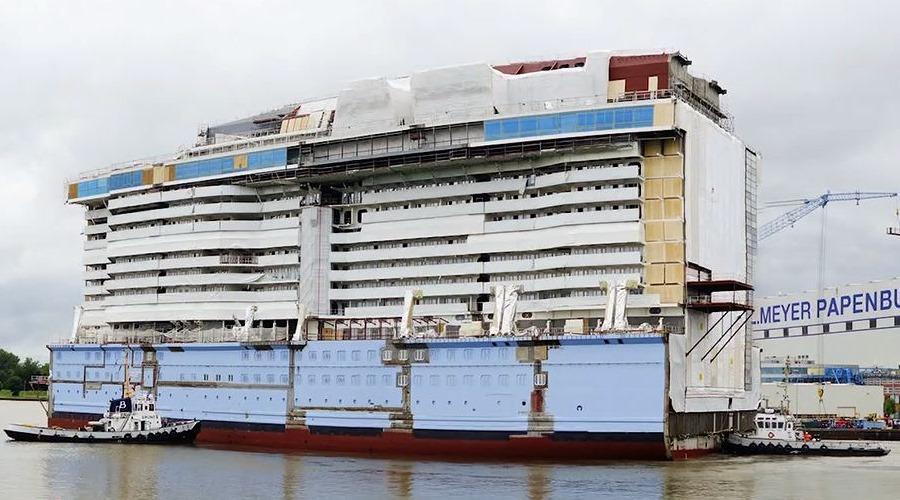
The ice-going cruise shipbuilding is so expensive as to hull strength and engine power, that the best option is to buy an unfinished vessel or to refit an existing Ice-class ship (often an ex-navy vessel), like the case of the Regent Seven Seas Navigator ship. Constructed as a naval support ship and strengthened for navigation in ice, the Navigator ship's hull was purchased from the former USSR (now Russia), while its superstructure was finished later at the T. Mariotti shipyards in Genoa, Italy.
The following YouTube timelapse video shows the Japan-made AIDAprima cruise ship construction process (shipyard Nagasaki Japan ). Next YouTube video shows the Aqua Mekong riverboat construction (time-lapse).
Cruise ship design
This is an amazingly detailed cruise ship design infographic showing what is what and where on a typical cruise passenger vessel. Note: Click on image to enlarge, backspace/back button to return to the article page.
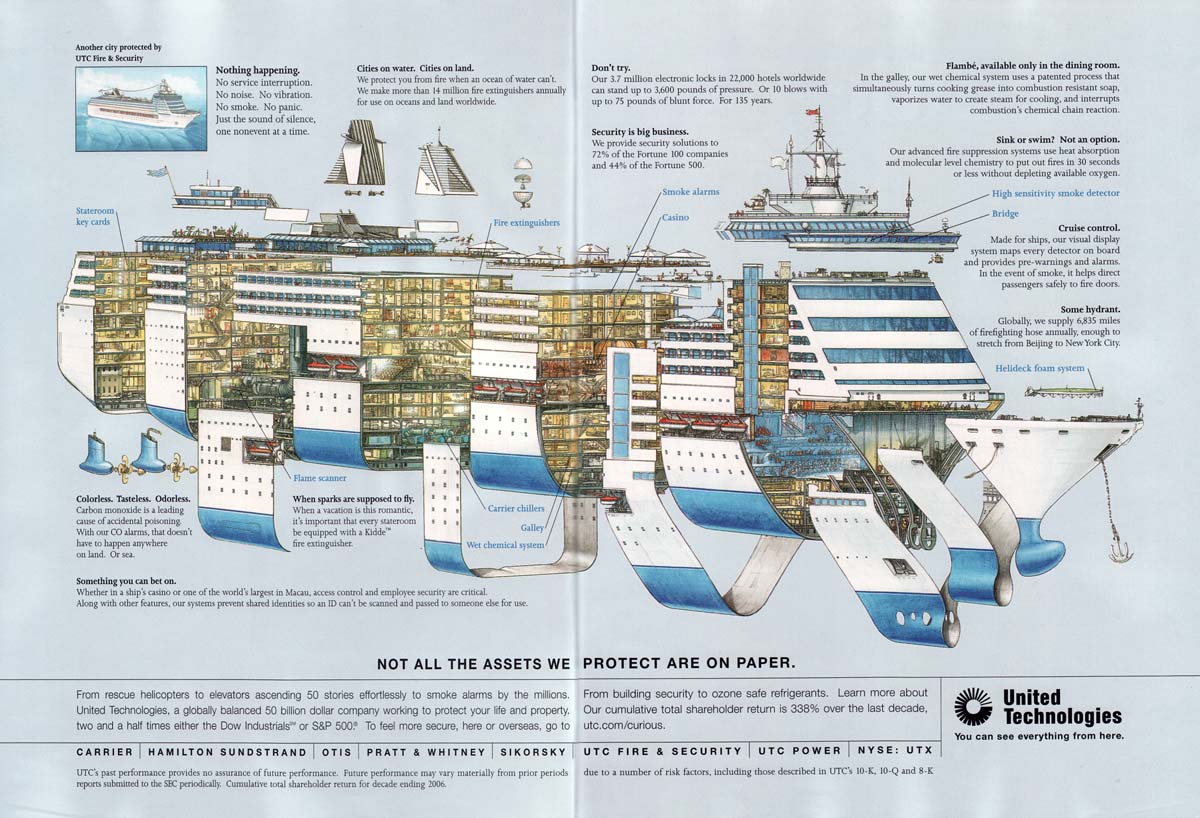
Marine design solutions for cruise ships are truly amazing and unique, using the latest innovations, technologies, and materials to ensure difference from other existing passenger ships. Special onboard features, such as the Royal Caribbean ships' rock-climbing walls, ice-skating rinks, surf simulators, wave pools, and the 9-deck high Zip-line are an irresistible temptation and a true allure for all the ship vacation fun fans. As to the common features, all big-capacity passenger ships have a several decks-high Atrium, at least 3 huge swimming pools, a Spa-Fitness complex, a grand casino, a library, duty-free shops, 2 huge capacity main restaurants, grand theatre, disco nightclub, kids and teen areas, numerous bars and lounges, and all-new big ships feature an open wraparound Promenade.
Cruise ship interior design
What about cruise ship interior designs? An example is SMC Design, which was appointed by Cunard Line to lead the development of the interior spaces on RMS Queen Mary 2 in preparation for liner's drydock refit in 2016. Cunard's flagship had a multi-million 25-day extensive refurbishment (May 27-June 21, 2016) that boasted new interior designs. The most iconic liner in the world opened the next chapter in her illustrious career. The announcement of the designer company followed the news that QM2 will gain 15 brand new single cabins and an additional 30 Britannia Club rooms during the refit. The popular onboard kennels were expanded in order to cater to the high demand this extraordinary facility already attracts.
SMC Design was established in 1994. The London -based design consultancy specializes in the maritime sector. SMC Design's team has worked on many cruise vessels - from small yachts to some of the biggest ships ever built. It also has a working history with Cunard liners, leading previous refits of QE2, Cunard Princess and Cunard Countess, while also being involved in its current fleet design: Queen Victoria , Queen Elizabeth and Queen Mary 2. Andy Collier, SMC Managing Director, was part of the launch design team of QM2 at the beginning of the Century. She was then the first Atlantic liner being built for more than 35 years.
New Russian cruise ship designs
In August 2016, at Lotus shipyard (Astrakhan, Russian) part of ASC (United Shipbuilding Company), the keel was laid for the 1st Russian passenger cruise ship in decades. Support for the new class of even vessel is coming from Russian Federation president Vladimir Putin, who expressed hope that this will be the first but not the last of a series of such ships.
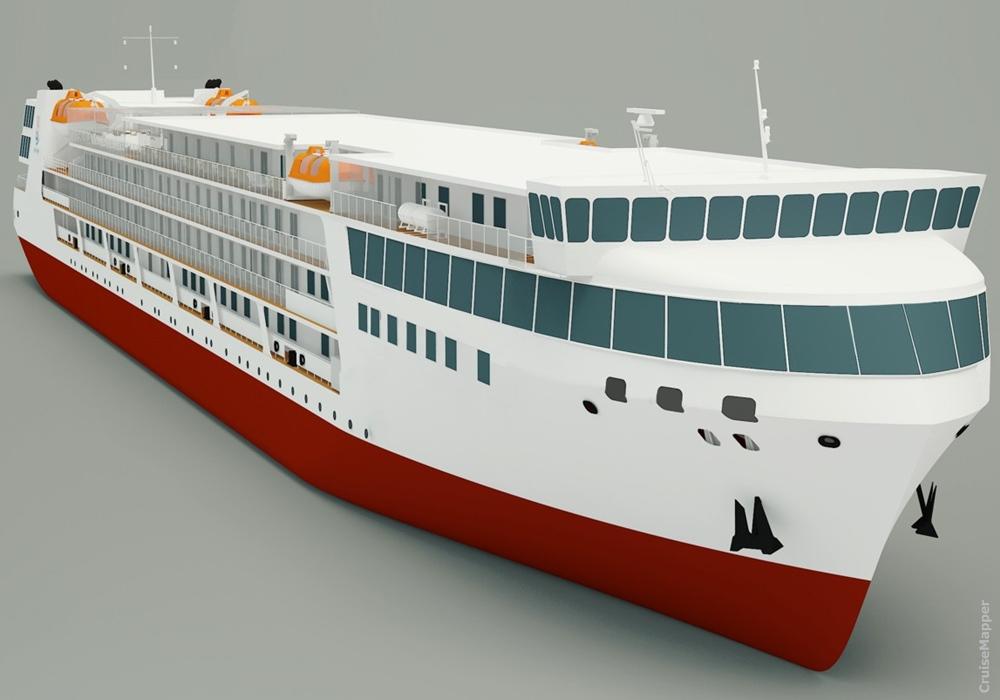
The Marine Engineering Bureau office engineers developed the Concept PV300VD cruise ship, the first of which is to be completed within 3 years. The project belongs to Saint Petersburg team of Marine Engineering Bureau SPb, which has been working in Russia for 16 years. Its other branch is in Odessa . Such vessels were not generally built in the old Soviet Union.
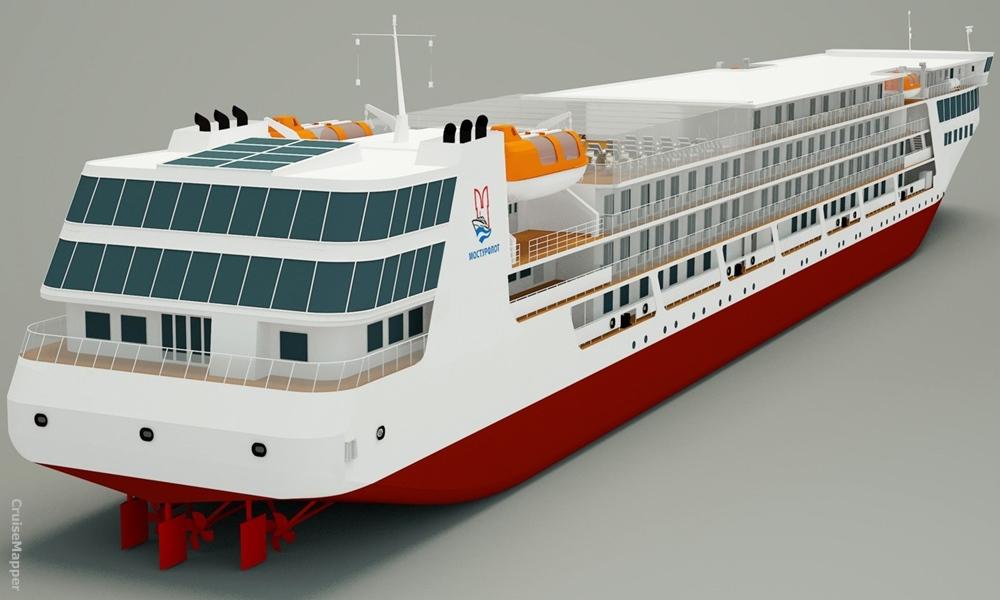
The last built in the USSR, 2 river cruise ships, Soviet Union and Lenin, were built at the Gorky plant in 1959-1960. Then, as with its ocean ships, the Soviet Union bought foreign-built river ships, until 1989-1990. However, these were not entirely foreign as they were created to Soviet order and developed for operation in Russian conditions. These vessels were built mainly in Austria, East Germany, and Czechoslovakia. After 1990, Russian riverboats were no longer built and the business was carried on for years utilizing old tonnage. The same happened with the Russian passenger fleet as they were banned in North America after Russia's invasion in Afghanistan.
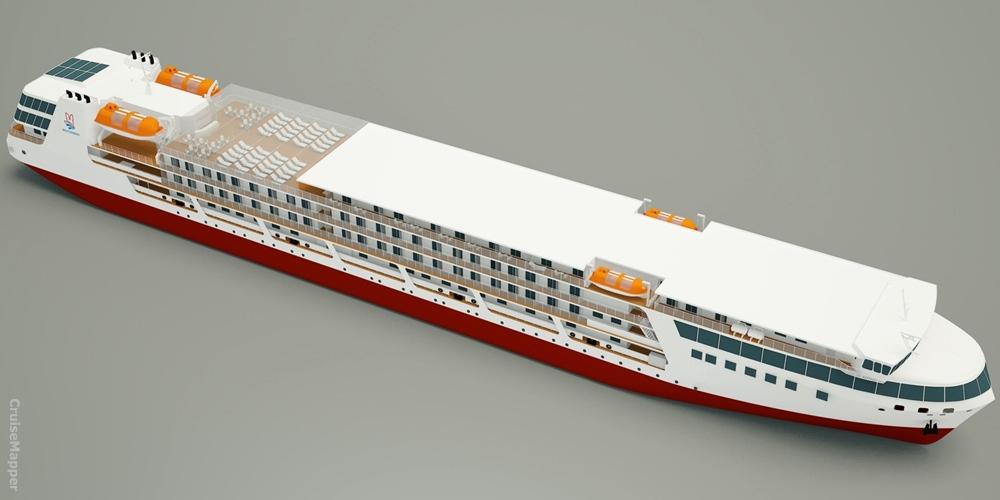
Today, shipping conditions in Russia are different. The new ships are planned to be "river-sea" ships. This class is needed in order to navigate large lakes. Russian river cruise ships are much more powerful than typical Danube and Rhine vessels. Dimensions for the new 310-passenger ships will be 463 x 55 feet. The PV300VD concept emerged in 2010-2015 by the order of the Russian Federal Marine Agency. The program's state customer and coordinator is the Minister of Industry and Trade, and completion is scheduled for 2019. The cost of a ship varies between 2.5 to 3.5 billion rubles and the payback period is 5 to 20 years. 3 such ships are foreseen at the stage, though more could follow. The next photo shows the design of Vodohod's new river cruise ship project PV300VD.
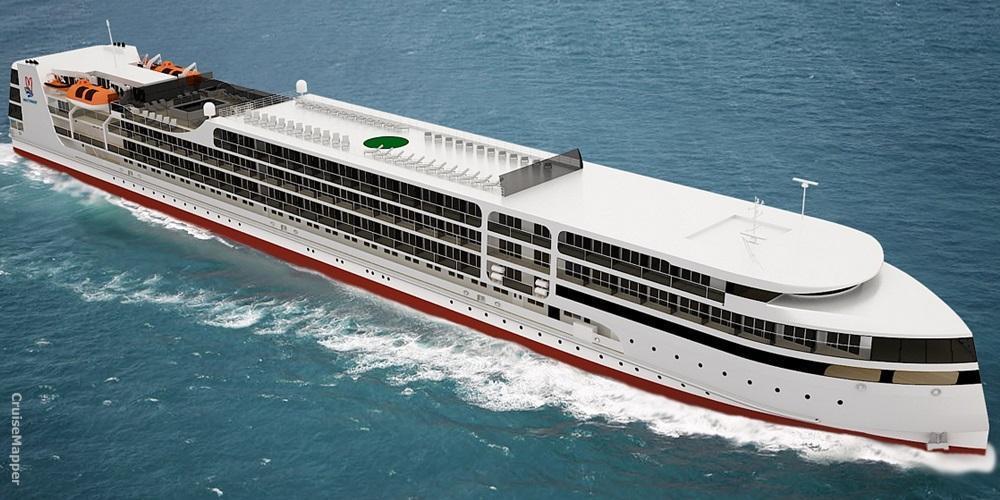
The next photo combo shows the design of Mosturflot's new river cruise ship project PV300.
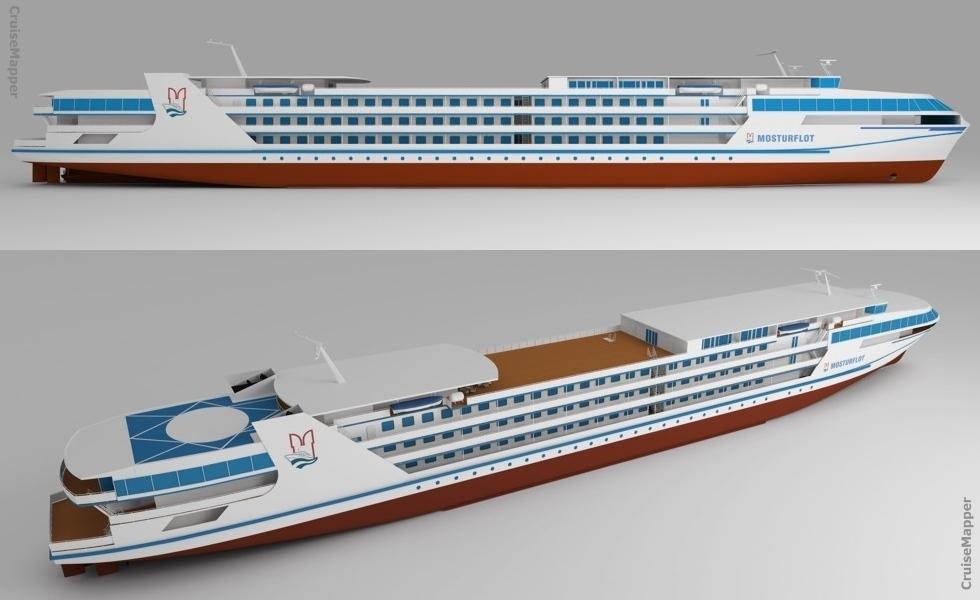
The routes foreseen for the new Russian ships are in season (May to October) between Moscow and Saint Petersburg, then taking travelers from Moscow to Samara and Rostov-on-Don, in the winter embarking in the Eastern Mediterranean and possibly the Red Sea: for example, Rostov-on-Don- Yalta- Odessa- Istanbul- Alexandria . There are talks about navigation in Crimea, Sevastopol, and Sochi, on more interesting routes in the Caspian sea.
The newbuilds could carry about 500,000 passengers annually, of which about 100,000 foreign tourists. The number of foreigners declined by nearly a half in 2014 as western tour operators cut Russian programs and westerners stayed away. According to the Ministry of Industry and trade, buyers of the new ship would be operators like Mosturflot (GK Sea and River shipping company), Vodohod and Orthodox. Given the high cost of the vessels, it is planned to lease them to operators. The main difference of this 4-deck ship is that it will be able to navigate not only rivers but seas as well. The vessels will also be more luxurious than past ships and will include western amenities, such as French balconies and comfortable large suites.
Next image shows a traditional European river cruise ship design (4-deck boat). All top-deck/sundeck structures (Wheelhouse, awnings, railings) are retractable and lowered when the boat passes under low bridges.
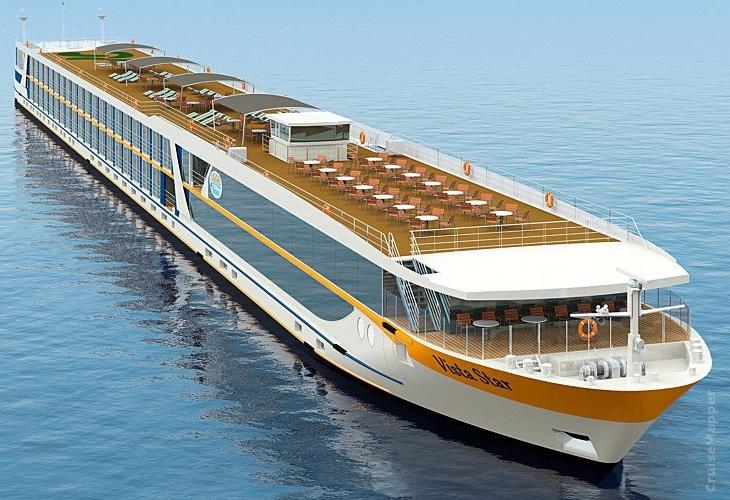
New expedition cruise ship designs
A new contract was awarded to the shipbuilder Uljanik (Croatia) for a 10,000-GT, 237-passenger ship ( Scenic Eclipse ) scheduled for delivery in 2018 but eventually postponed to 2019.
Based on these dimensions, the new ship was to be of the same general size as Ponant's fleet, the latest of which ( Le Lyrial ) was built at Fincantieri 's Shipyard Ancona Italy . Uljanik has not disclosed the identity of the purchaser, but new ships are also expected from Lindblad and Seabourn in 2018.
Next photos show other designs fitting the expedition vessel category.
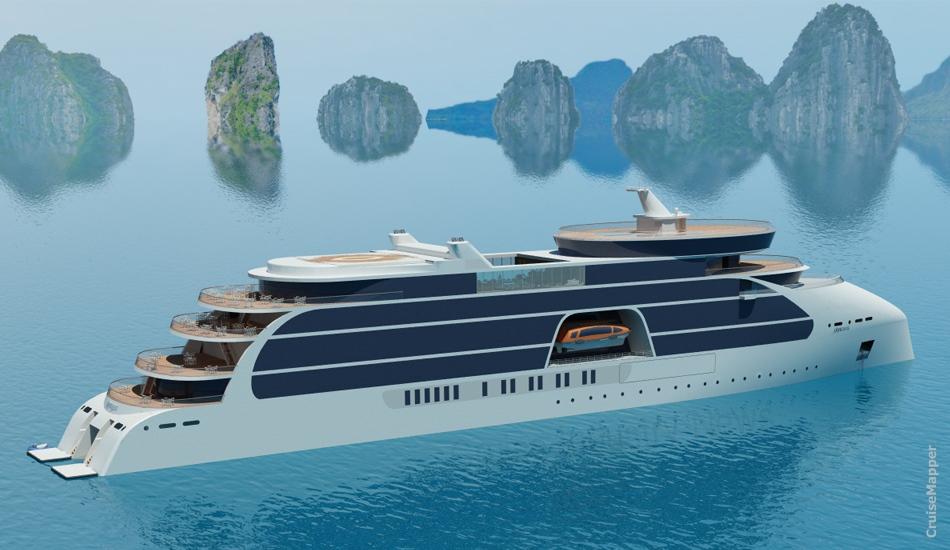
The above is STX France's Project Ulysseas (145 m length, 200 passengers) was officially revealed in March 2015.
Next is the 2020-announced icebreaking cruise ship design developed by Knud E. Hansen.
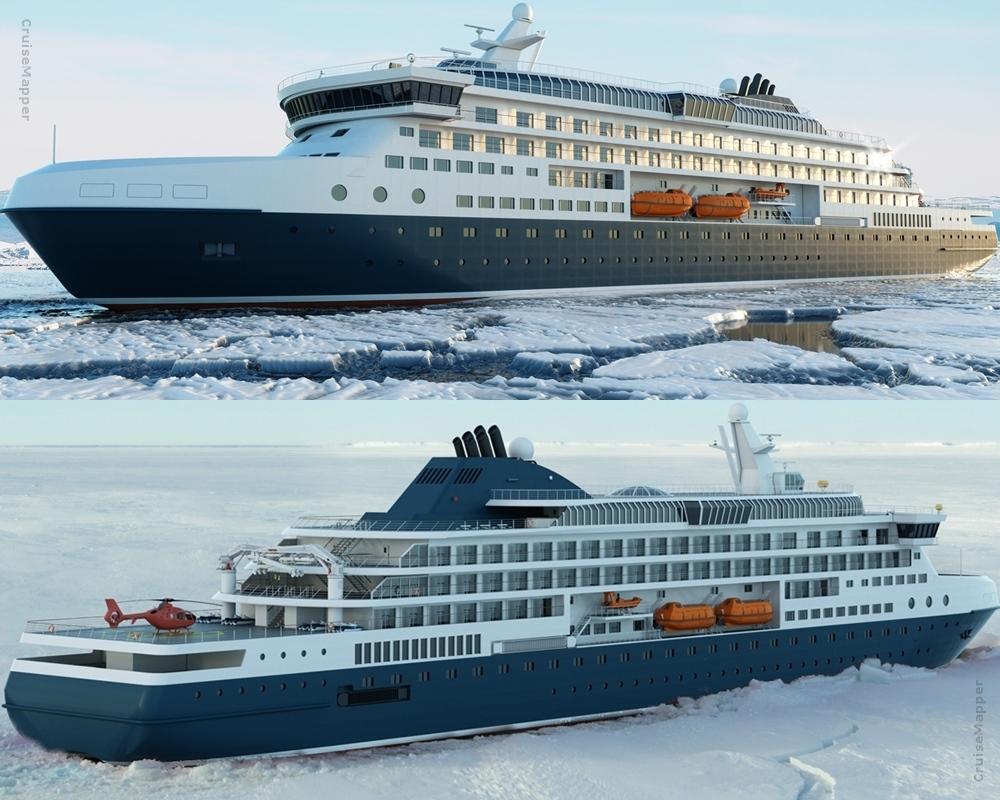
The PC3 ice-classed vessel has deadweight/DWT 1965 tons, LOA length 144 m, beam 22 m, draught 7 m, max passenger capacity 300 (plus 150 crew) and 150 staterooms. Most cabins are with step-out balconies and interconnecting, featuring the company's "Flex Cabin System" which allows their walls to be reconfigured in order to convert a Suite into two separate cabins.
The newbuild has max cruising speed 17 knots (20 mph / 32 kph), can operate in solid ice (max thickness 1,8 m) and has diesel-electric propulsion (based on 2 azipods, total power output 15 MW), 6 electricity generators (dual-fuel / LNG and MDO-diesel) plus a lithium-ion battery pack (powers the ship while docked). The new passenger ship design features an Ice Bar, multi-purpose Lounge, a tender garage (for Zodiacs and other expedition equipment that can be launched via a portside shell door), an aft-located helicopter deck (where a helicopter is lowered into the hanger on the below deck).
The next design (by Aker Arctic) is of an expedition ship ordered by the UK-based company Polar Cruise Enterprises Ltd. The vessel has LOA length of 135.5 m, Beam 17.8 m, Draught 5.5 m, Propulsion 2x 3.5 MW azimuth thrusters, Engines 4x MAK 6M32C (2,88 MW each) allowing max cruising speed 13 knots (15 mph / 24 kph).
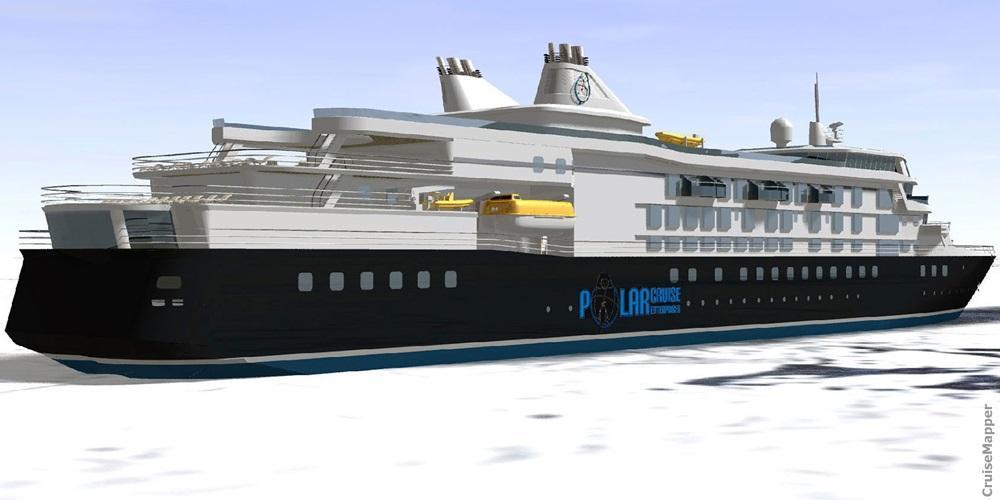
Knud E Hansen's expedition ship design is with 150 staterooms and heavy-duty, ice-rated hull.
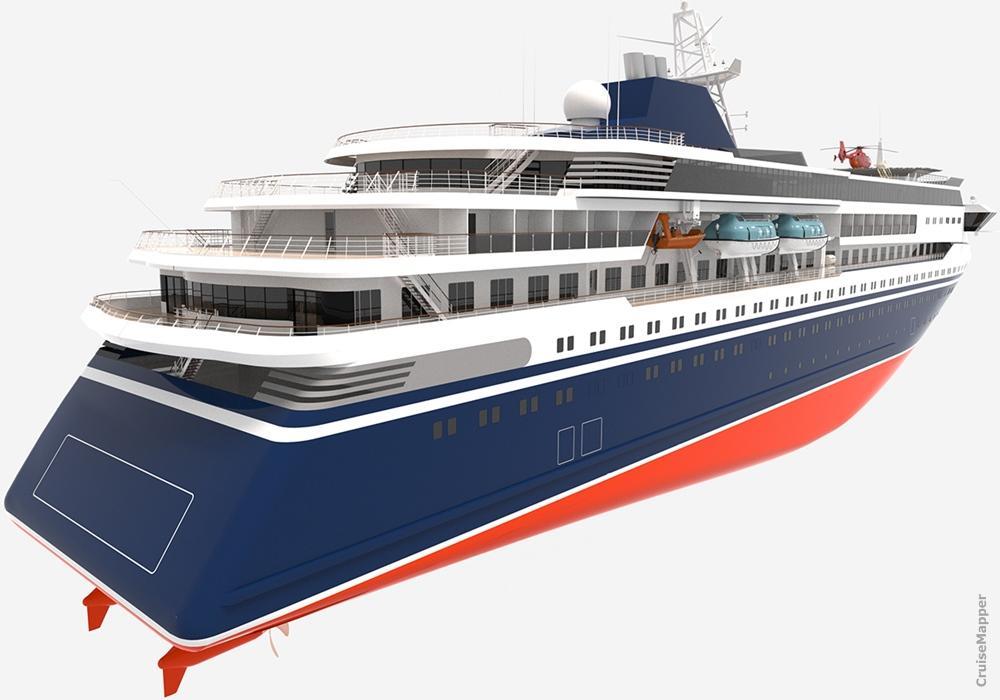
The next video shows various passenger and research ship designs developed by Knud E Hansen (Danish marine engineering company established in 1937).
Next is the VARD-6 polar ship design on which are based the newbuilds of Ponant (Explorers-series), Hapag-Lloyd (Hanseatic-series), Viking Expeditions and Coral Expeditions (Australia).
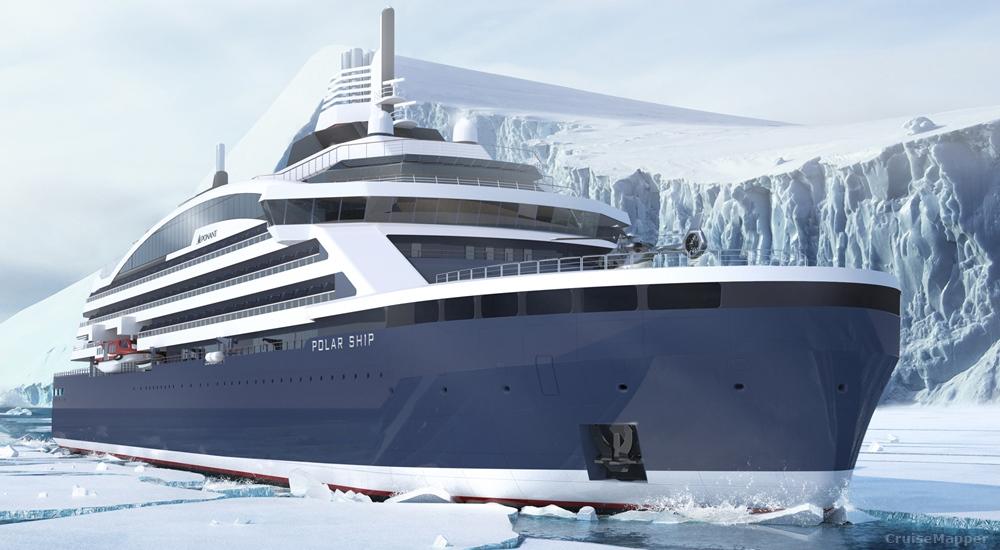
Next images show expedition yacht cruise ship design by the Dutch shipbuilder Damen Group. The vessel is "Polar Class 6" (with ice-strengthened hull) and has endurance 30 days autonomous cruising.
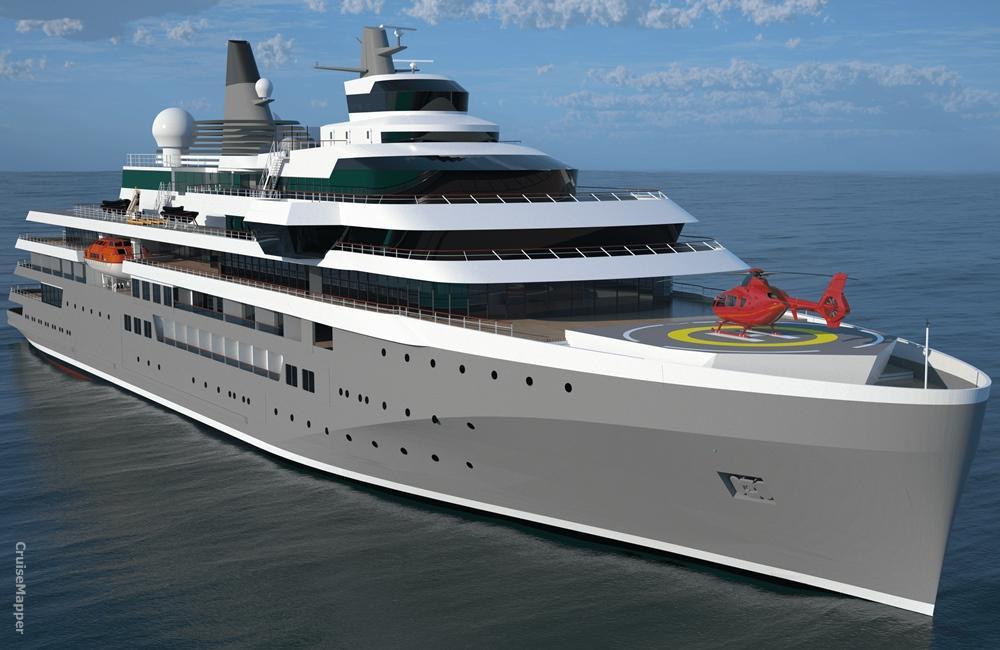
The ship has approx 1100 m2 public space and 2500 m2 outdoor deck space. Max capacity is 115 passengers. Propulsion is a diesel-mechanical hybrid and encompasses IMO Tier 3 compliant medium speed engines.
Damen Shipyards new expedition cruise ship design
Damen's cruise vessel is "battery ready", which means it could be equipped with a battery system for peak-shaving (reducing peak demand), providing supplementary power for maneuvering or silent drive operations. The hybrid propulsion is the best fuel-efficient technology currently available, allowing service speed 16 knots (30 kph / 18 mph) and max speed 18 knots (33 kph / 21 mph). The next aft view image also shows the ship's marina platform.
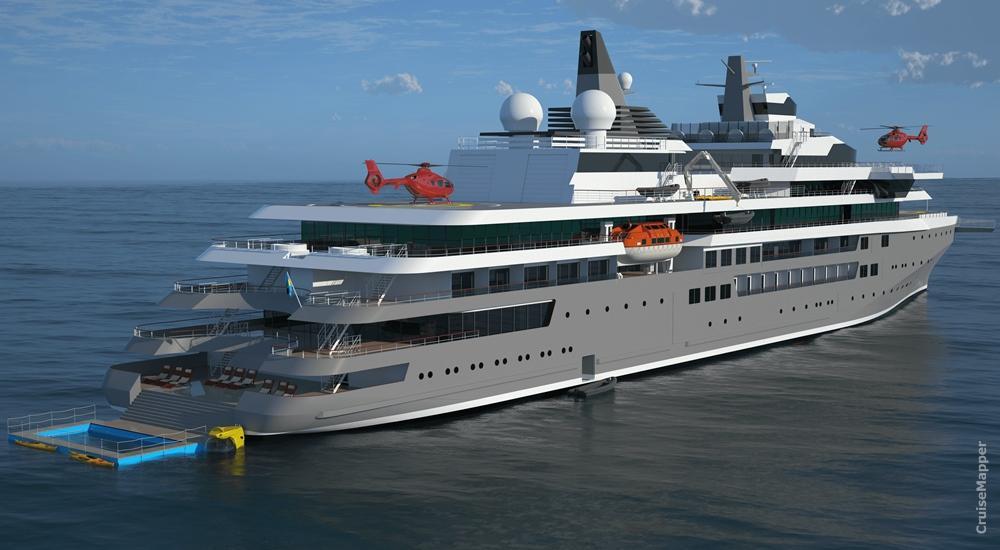
SunStone's "World-Class" expedition cruise ship design
On March 16, 2017, SunStone Ships Inc (USA) signed an agreement with the Hong Kong-based "China Merchants Industry Holdings" (CMIH) for the construction of 4 units based on the "ULSTEIN CX103" design. SunStone is currently the world's largest (by GT tonnage) shipowner chartering exclusively expedition vessels to the cruise travel industry. The contract included the option for additional 6 units.
The ice-class 1A vessel has the following polar code specifications.
- Designer: SUNSTONE SHIPS INC
- Shipbuilder: (CMIH) CHINA MERCHANTS INDUSTRY HOLDINGS
- Passenger cabins: 80-95
- LOA Length: 104 m
- Beam / Width: 18 m
- Speed: 15 Kn / 17 mph / 28 kph
- Ice-Class: 1A
- Polar Class: PC 6 (highest)
The boat has a fleet of Zodiacs (20-22x aft-stored inflatable RIB boats) and features a dedicated Zodiac loading platform for easy boarding.
Charterers of these ships are the travel brand companies AQV-American Queen Voyages , Aurora Expeditions ( fleet ), Albatros Expeditions ( fleet ).
STX France "Ulysseas" cruise ship project
In March 2015, the major shipbuilder STX France unveiled a revolutionary new expedition ship design named "Ulysseas". It represents an innovative idea for a small cruise ship ( passenger capacity 200, ice-class hull, length 476 ft / 145 m, cruising speed 17 Kn / 20 mph / 31 kph) aimed at the expedition cruising market.
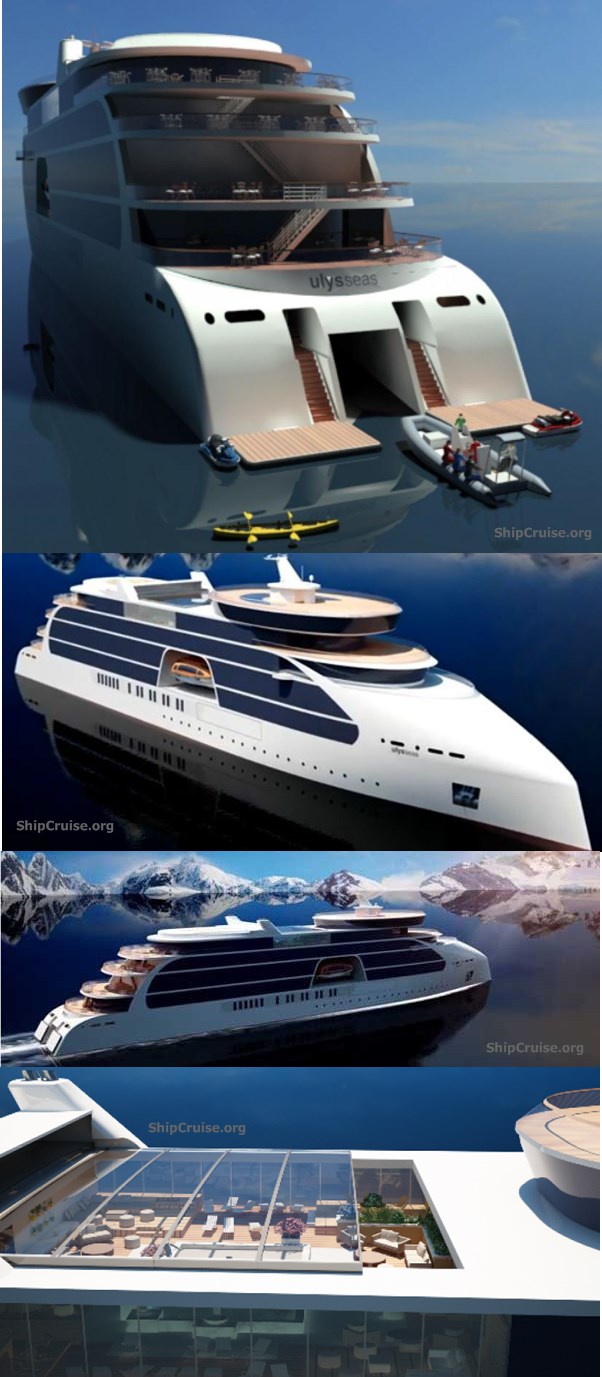
The main reason for the Ulysseas project is that currently, the expedition cruise market uses mostly second-hand vessels. Unique for this new ship design is the excessive usage of glass (in all public areas) and the French balconies (false balconies) on all passenger cabins. Every passenger-use facility on the new vessel features floor-ceiling windows. There will be a unique forward-located observation lounge for 360-degree views.
The Ulysseas ship's aft-section is an STX-patented design for saving energy. This is a movable duck-tail, which position depends on cruising speeds and weather conditions. The vessel is powered by two 2,5 MWT azipods (360-degree rotating thrusters), with 4x diesel-electric generators and 1x scrubber. This cruise ship design also features a helipad (helicopter landing pad), a helicopter storage space (inside the ship), zodiac boats for ship-to-shore operations.
(2018) "Silenseas" sailing cruise ship design by Chantiers de l’Atlantique (fka STX FRANCE)
In early March 2018, STX France revealed a carbon-free cruise vessel design (trademarked Silenseas) using wind as main power source. The new wind-power technology was trialed on Ponant 's yacht Le Ponant , on which one of the existing sails was replaced and the new technology tested.
STX France's project was something never done before. The carbon-free sailship design is an alternative to the popular hybrid-powered vessels. Hydrogen and fuel cells are still expensive, plus hydrogen is not available in most ports.
The technology uses the company's patented "SolidSail" concept. The sails (total size up to 1200 m2 / 12900 ft2) are mounted on masts but without any ropes or cables. The STX France design has 3 masts and 3 rigs, with masts rotating in order to adapt the sails to the wind. The new design also includes the latest hybrid propulsion technologies, combining wind with LNG, and potentially batteries, solar panels, and fuel cells.
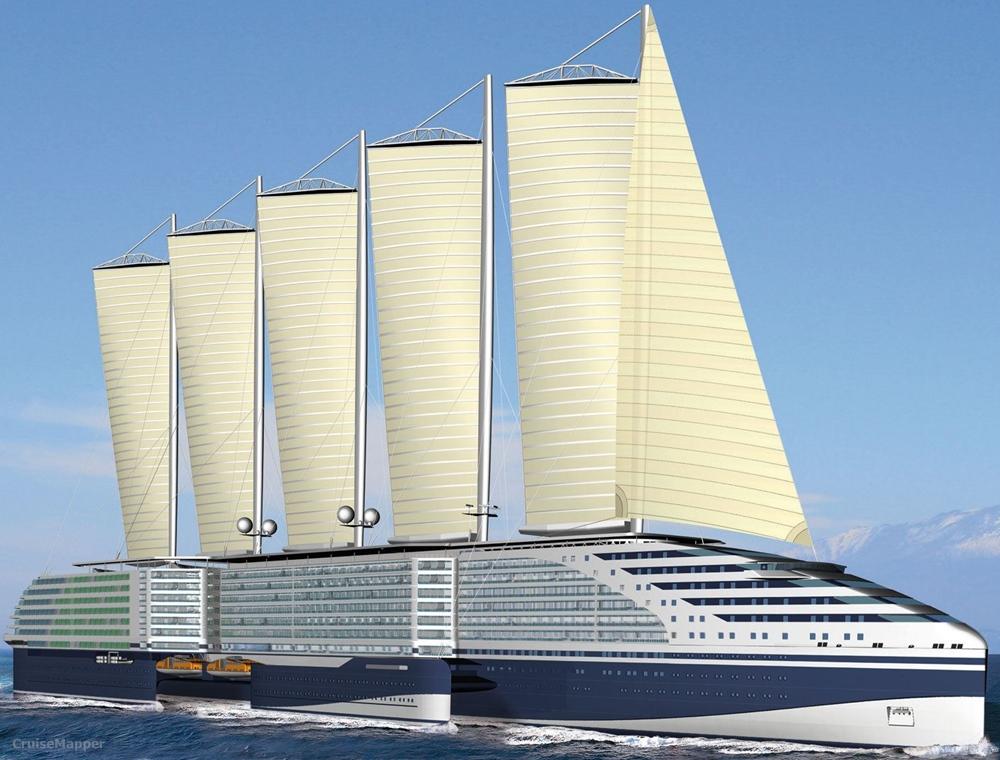
The sailing ship can reach speeds of 12 knots (14 mph / 22 kph) under sail in 15 knots (17 mph / 28 kph) winds. In winds over 15 knots, the vessel's propellers will be used, acting as a turbine that draws power from the sails. On Caribbean Sea routes, the new technology could reduce propulsion energy by 60%.
STX France's sailship design was developed for 3 vessel sizes, the biggest being 15000 GT-ton with LOA length 190 m (620 ft) and 150 passenger staterooms. The French shipbuilding company started research in sail propulsion in 2009, Silenseas has technology patents (2009 and 2017) for the new sail. The unit is made from fiberglass, carbon and epoxy-resin panels.
SolidSail system debuted on October 31, 2018, on the yacht Le Ponant. The new Solid Sail (sized 300+ m2) was constructed at Chantiers de L'Atlantique ( Saint-Nazaire ) and installed in Marseille . The 3-masted Le Ponant departed from France to Cape Verde Islands, then embarked on a Transatlantic crossing to Cuba, testing the new sail for 1 year.
Similar is the concept of Peace Boat's new vessel Ecoship (built by Arctech Helsinki Shipyard in Helsinki, Finland ).
In December 2022 was announced the shipyard's first SolidSail with a carbon-fiber mast. The project was a collaboration with the Lorient -based companies Lorima (manufacturer of carbon fiber masts and spars), Avel Robotics (manufacturer of composite parts), CDK Technologies (boat building company) and Mulitplast ( Vannes -based shipbuilding company).
The carbon-fiber SolidSail mast has height 66 m/217 ft, width 2 m/7 ft and weight ~20 tons. It can carry a SolidSail sized ~1500 m2/16150 ft2.
Silenseas' SolidSail will propel the world's largest wind-powered/sailing cruise vessel - Accor's Orient Express Corinthian/fka Silenseas (2026).
Aeoldrive (rig comprising the mast and the SolidSail) is fully automated and 360-degree rotating, while the masts rotate/tilt up to 70 degrees (when the vessel passes under bridges).
(2019) "Wind Cruise Vessel" design by KNUD HANSEN
On June 19, 2019, KNUD HANSEN announced its medium-sized (LOA length 110,3 m / 361 ft) long "Wind Cruise Vessel" design. This sail-assisted ship has max passenger capacity 100, max speed 15 Kn (17 mph / 28 kph), operational range 6000 nm (6900 ml / 11100 km), draught 4,5 m (), TDW-deadweight tonnage 730 tons. The new sail-ship targets the expedition travel market and passengers who prefer destinations inaccessible by larger vessels.
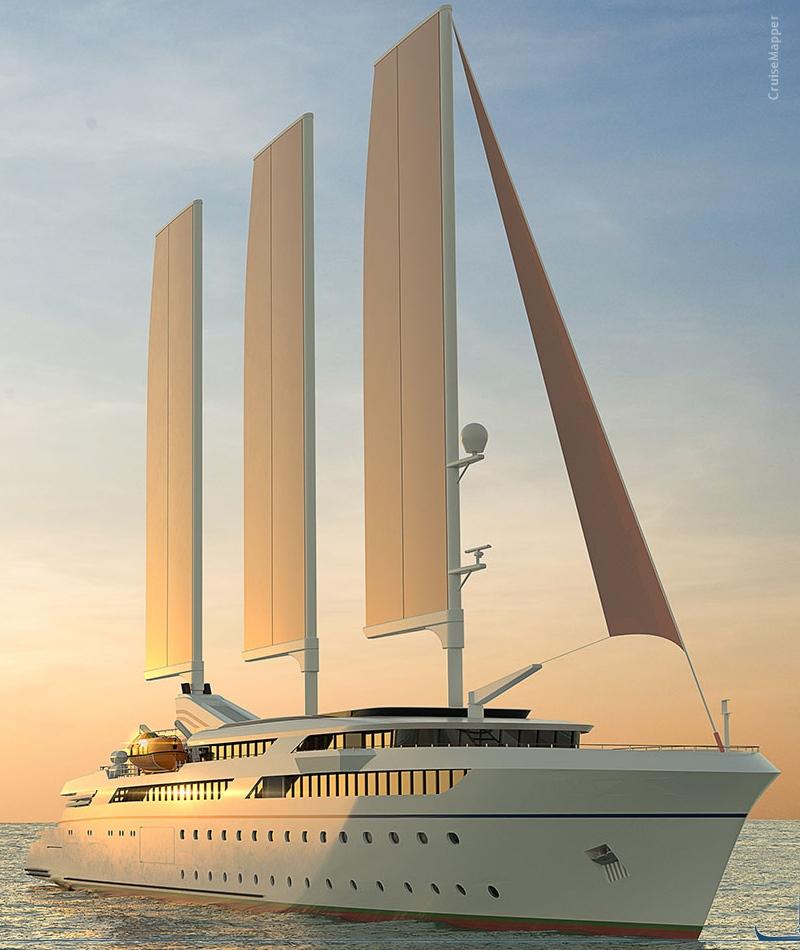
The vessel is powered by 4x low-sulfur ULSD diesel engines (plus wind power) and also includes a large battery pack (for zero emissions while in port and protected marine zones). The rig is designed by Detlev Loll Ingenieurburo GmbH ( Peenemunde -based company) and comprised of 3x free-standing masts. Each mast is fitted with a fully-battened sail with adjustable flaps (wing devices that increase the max lift coefficient that a wing can generate). Ship's total sail area is 1910 m2 (20260 ft2). The sails are computer-controlled and designed for peak performance even in light winds.
The propulsion system is based on aft-located twin-screw propellers (fixed) and two fore-located tunnel thrusters (for better maneuverability in ports and anchorages). In sail-assisted mode, two fin stabilizers limit the ship's heel/listing to just 6 degrees.
Cabin decks house 48 passenger staterooms (46 cabins plus 2 suites) - all outside and many with balconies. Sea Lounge features underwater porthole windows. Deck 2 has a large tender boat garage for Zodiacs (rigid inflatable boats), jet skis, scuba diving gear, and other equipment. The ROV (remotely operated underwater vehicle) is fitted with HD camera equipment underwater observations at max depth 3 km ()9840 ft). Deck 3 is the Sun Deck featuring a swim platform with a ladder for easy water access. On Deck 4 are the restaurant (with outdoor terrace), bar, library, card room. On Deck 5 are the aft-located bar lounge and the bow-located observation area. Deck 6 has an open-air cafe and sun deck (sunbathing area with deckchairs and loungers).
Cruise ship building vs ship refurbishments
Unlike the scheduled cruise ship refurbishments , major refits may include even a cruise ship lengthening, like in the case of Royal Caribbean ship Enchantment of the Seas lengthened in 2005 (see the photo below). The Enchantment ship lengthening cost ~ US$55 million, it was a process of cutting the ship in two and inserting a whole new 73 ft (22 m) 3,500 tons midsection, pre-built at the Aker Finnyards.
The month-long dry-dock at the Keppel Verolme shipyards (Rotterdam, The Netherlands) resulted in adding 151 brand new cabins, a 50% bigger Pool Deck area, a new kids area, a teen centre, several new bars and lounges, an expanded main dining room, a new specialty restaurant. This "refurbishment cost" record was recently beaten by the CCL line and the US$155 million Carnival Destiny refit 2013 producing a brand new ship named Carnival Sunshine!
The average cost of building a cruise ship is around the US $450 for mid-sized vessels and up to $800 million for bigger cruise ships. These prices, along with the current economy status force many cruise lines to hold off from building new ships - the biggest expense of all. As a rule, all new cruise ships on order/currently under construction are by contracts signed years ago when the dollar had a good rate.
Cruise shipbuilding prices are high enough to not meet the return requirement. Even the mighty Carnival Corporation (the world's largest cruise shipowner) puts its shipbuilding plans on hold. Royal Caribbean is one of the few companies continuing to place orders for new ships - and not any ships, but the ever largest, the most innovative, the most expensive in the world. Still, most passenger ship lines are trying to keep their current fleet fresh and good looking. Two of the best examples are Holland America with its $450 million SOE program for ship renovations, and Carnival investing $250+ million to fully refit and refurbish 8 of its oldest vessels.
The next photo shows the construction of the world's largest cruise ship - Harmony of the Seas - at Saint-Nazaire (STX France) .
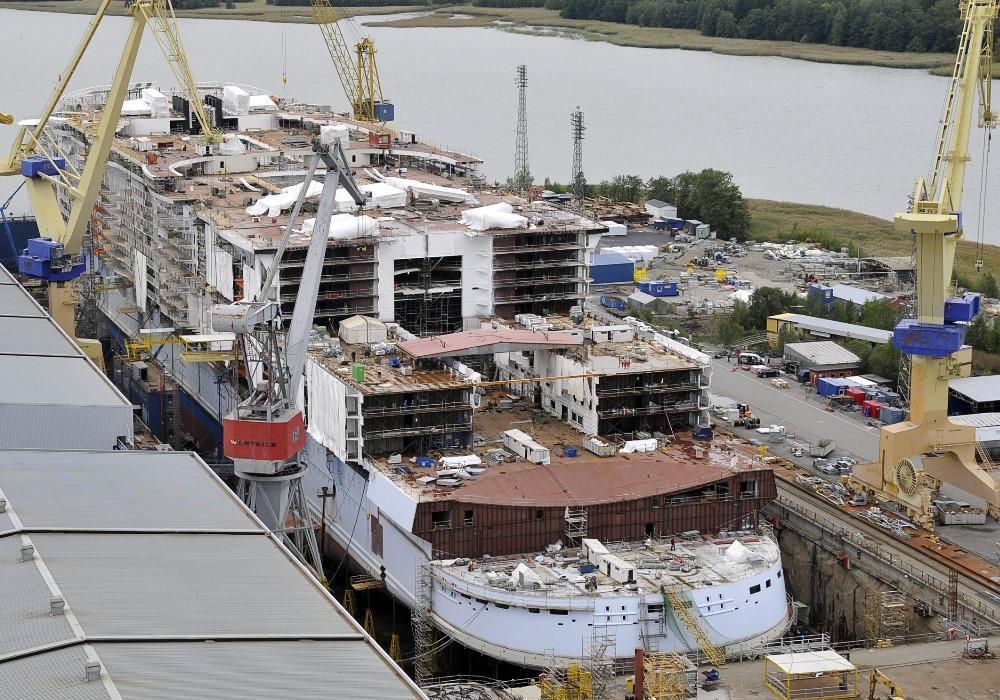
The following tag link lists all of CruiseMapper's news related to shipbuilding .
Streets of Monaco Superyacht
"Streets of Monaco Superyacht" is a futuristic project developed by Yacht Island Design. The vessel is modeled after the actual city and designed for billionaires to sail and play.
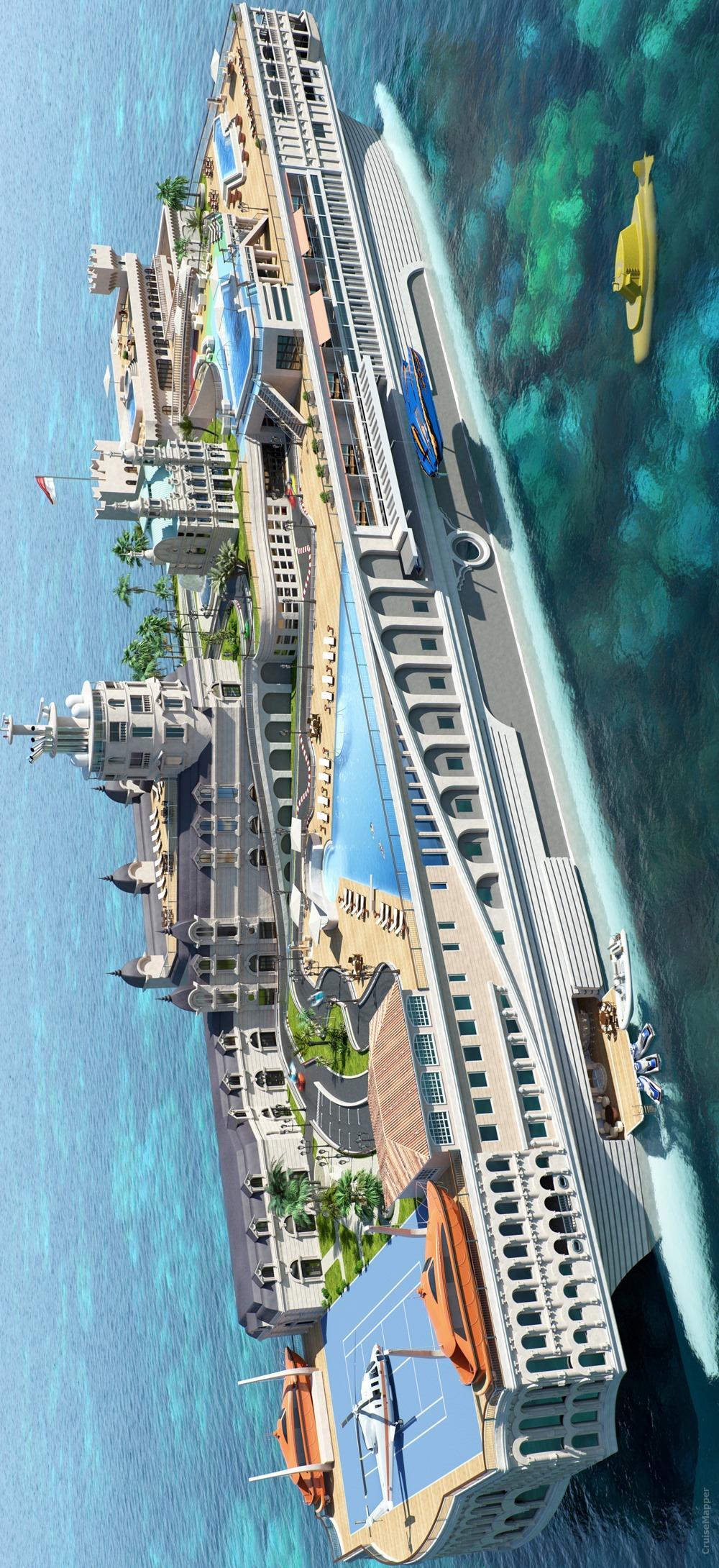
The 500-ft / 152-metre-long ship is lined with scaled-down versions of Monte Carlo's most famous buildings, including the Casino and its Grand Prix course (which on the yacht doubles as go-kart course). Among the most prominent amenities on this superyacht are swimming pools, cafes, full-service spa, full-size sports court (doubles as a helipad for private helicopters), library, interior parking for smaller boats, mini-submarine.
Staterooms (1VIP Suites) are sized 3800 ft2 (350 m2) each. There are also cabins for the 70 crew and staff members. The Superyacht cost about USD 1 billion.
Havyard's sightseeing cruise vessel design
In July 2019, Havyard Group ASA (Fosnavag Norway-based ship technology company) and SINTEF ( Trondheim Norway -based research company) started a project for designing a new environmentally friendly sightseeing cruise vessel specifically for touring the Norwegian Fjords, as well as a new Norwegian Coastal cruiseferry design. The project includes measuring energy consumption, hull optimization, developing new-generation equipment and using renewable energy sources.
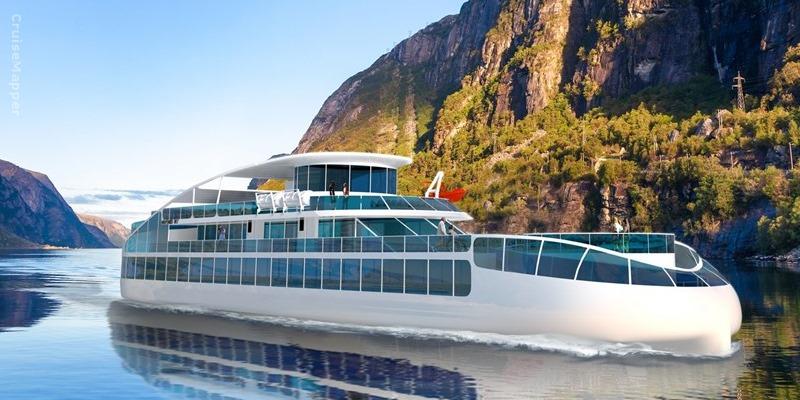
These ships are designed with battery-power propulsion (zero-emission) and recharging in call port. The vessel has LOA length is 70 m (230 ft), max passenger capacity between 600-800, max speed 10-11 knots (20 kph / 13 mph), floor-ceiling and wall-to-wall windows throughout (for unobstructed fjord cruising experiences), wheelchair-friendly interior and exterior spaces. The new vessel's designer is Stig Magne Espeseth.
Passenger embarkations/debarkations are at floating hubs (platforms at sea) installed at the fjord's mouth and outside the itinerary's seaports. The hubs also double as charging stations for the smaller-sized vessels.
Cruise Tourism
The cruise industry is a modern phenomenon but it rooted from the early years of the 19th century. As travel by ship was the only means to travel overseas. The Duke of Bridgewater was initiated to start water transport services from Manchester to London in 1772. His boat was used to carry passengers as well as goods.
In 1815 steamboats were developed and used to carry passengers and goods. To launch first cruise ship the credit goes to the king Charles IV of Sweden when he started his personal cruise ship in 1821 . In 1824 the first commercial cruise ship was started under the flag of Ireland. Gradually, steamship excursions became so famous and it resulted in the introduction of modern age cruise lines.
In 1938 the Peninsular and Orient steam was launched first long distance steamship services from India to the Far East. This company is still operating and has a good grasp of the cruise market. The Cunard ship company followed the P&O company and began regular services to the American Continent in 1840.
During the 2nd half of the 19th century, Britain dominated the cruise industry. However, this dominance has decreased in the later century with the advent of the substantial emigrant from Europe and the steady growth of US visitors to Europe.
Thomas Cook (the father of travel agency business ) stimulated the British tourists to visit North America. In 1866 he succeeds to operate first steamship excursion tour to the USA.
In the modern age, UK started first transatlantic lines ‘Titanic’ in 192 which was sold to the Newfound-land Islands in 1913. Second important cruise line ‘Queen marry’ was started in 1934 . It had 2000 passengers capacity along with 1100 crew members. It offered every facility for passengers such as comfort, safety, and entertainment. It was considered one of the great ocean liners.
In 1938 another larger sister ship Queen Elizabeth was launched by the same company. During the Second World War, these ships were used to carry British troops but after the war, their main business was to carry passengers across the Atlantic.
The year 1958 was the turning point in the steamship travel, as commercial jet aircraft has ended the dominance of steamship. By 1970’s steamship travel was only a curiosity. Due to less demand, high fuel prices and long duration of the journey all these resulted in the closing of many cruise company. Even many ship companies went bankrupt.
During 1980’s some large ships were converted into luxury liners, offering holidays to travelers who have money and time. Many cruise lines have taken the place of scheduled liner services.
The cruise industry is currently the fastest growing segment in the world tourism market and all tour operators now include cruises in their tour package.
Definitions of Cruise Tourism
The cruise tourism is an increasingly important part of the employment structure of advanced industrial nations as well as developing economies. Many of the cruise industries key players have made a significant contribution to the economic growth and development of the nation such as Star Cruises, Holland and American line Deluxe cruises. Crystal Cruises, Silversea Cruises, Princess Cruises, Royal Caribbean, and so forth.
Cruise tourism provides and offers food, beverage, accommodation, recreational, casino, shopping, and other services to the tourist. It is like an informal industry which makes an arrangement of various services i.e., cruise packages and combines these with air travel to attract the potential customer.
The cruise package includes a plenty of facilities designed to meet the specific requirement of passengers – such as accommodation, food, beverage, deck games, swimming pool, yoga classes, quiet lounges, sheltered dock, library, casino, disco films.
Many cruises include special interest themes – like astronomy, yoga, meditation, sequence dancing, classical music and many more.
Cruise Tour Package
A cruise tour package may be defined as a systematically planned return journey with entertainment and recreational facilities on board, and shore excursion. In other words, the cruise package is a pleasure an all-inclusive trip by boat or ship for specific days, to specific days, to specific destinations, and with a set price.
Cruises packages may be designed and planned for an individual group, families, FITs, business executives, honeymooners, and special interest tourists. Of course, these cruise packages are designed for cruise passengers. However, these could not be segregated from air travel and land arrangement.
Types of Cruise Tour Packages
If we see the cruise packages offered and marketed by tour operators and travel agencies , we find similar as well as more ingredients in cruise packages such as port handling charges, airport taxes, visa processing charges and so forth. Therefore, the elements or components of a cruise package may vary from tour company to company, destination to destination and from region to region.
On the basis of above discussion actual cruise industry environment the following main cruise packages are offered by cruise liners:
- Incentive Cruise Packages
- Group Packages
- Family Packages
- Business Cruise Package
- Honeymooners Package
- Special Interest Cruise Package
- Fly Cruise Package
Types of Cruise
Since the introduction of the first cruise in 1821, numbers of cruises came in the cruise industry. Some of them are still operating in the industry while others which were not attracting clients discarded from the industry. Thus, the following typology is based on sales, marketing and working conditions of the cruises:
Volume Cruise
As the name indicates, volume cruises concentrate on volume turnover. That is why these are called mass market cruises. 65 percent of all cruises are volume/mass market cruises. These cruises are very popular in the Caribbean sea, Asia Pacific and South East Asia.
In such cruises, accommodation and other services are comparable to the star hotel. Generally, these cruises emphasized two things i.e. Turnover and short-term passenger itinerary. These are further divided into three sub-categorized:
- Short term cruises – Normally two to five days.
- Standard cruises – For one-week duration.
- Large cruises – Duration is from the week to two weeks.
Premium Cruises
Premium cruises are the second largest segment of cruise industry accounting for mere than 40 percent of all cruise revenues. The duration of this cruise varies from one week to three months.
Due to this, these are known as upscale cruises. Their product and services are equivalent to its class resort, and hotel. Royal cruise, Star Cruises, Princess Cruises, Panama Canal Cruises are offering premium cruise service.
Luxury Cruises
Luxury cruises occupied a meager percentage of the cruise market. It may be due to its high-quality product and services and it focuses on long-haul itineraries for exotic destinations. These cruises are meant for elite people. The duration of itinerary may range from 6 months to 12 months.
In spite of high prices, these cruises are more popular among the tourists and honeymooners. Luxury cruises are operated by the Royal Caribbean cruises, Crystal Cruises, and Star cruises etc.
Specialty Cruises
These cruises are launched to cater the demands of specific interest passengers, such as newly married couple, whale watching, oceanography, scuba diving. The quality of products and services is comparatively low as other cruises. The duration of these cruises is very less but depending on the package.
Presently, there is more than 150 cruise ship with 90,000 cabins world over . The largest cruise lines is Royal Caribbean cruises liner (RCCL) with nine ships and have a capacity of 15,000 births. The Star Cruises is the 2nd largest cruise lines having five ships with 7000 births capacity. Followed by Deluxe cruise lines, Crystal Cruises, Radisson seven seas cruises, Seabourn cruises, Silversea cruise and princes cruises etc.
Significance of Cruise Industry For Tourism
The tourism industry in many countries of the world has been profoundly helped by the cruise sector to shape the tourism product and to satisfy the sophisticated travelers.
The relationship between the cruise industry and tourism industry is, therefore, a highly complex subject involving a mixture of socio-economic factors, technological factors, market pressures, government policies, management attitude ad tourist expectations.
The following points can be perceived pivotal for the significance of the cruise industry:
- Evolving cruise as a vacation option.
- Realizing the competitiveness.
- Development in MICE destinations.
- Image Conscious.
- Increasing the size of the cruise market.
- Alliances and Networking.
- Shifting tourist demands.
- Re-structuring ownership.
- Labor flexibility and Employment.
- Boom-bust cycles and tourism.
Process for Development of Cruise Tour Package
The development of air transportation and improvement in their technology in so far as safety, speed economy, and comfort are concerned to have admittedly hurt the cruise industry. However, steamship travel remains as today’s transportation of pleasure, relaxation, and comforts with service comparable to country’s best hotels and resorts.
The cruise industry is now a resort or hotel activities that must be promoted as floating hotel/resort, not for just vacation at sea but a romantic interlude, wedding anniversary, mind-dazzling, nightlife, resort cruise, and a pleasure of meeting new people.
Many thousands of rupees are spent annually by the cruise companies to promote their products and services directly or, through the tour operators and travel agents but a crucial question remains unanswered. What should be included in the cruise package? How it is to be marketed? What will be the core ingredients? In many cases, tour operators failed to find the right mix of cruise package for their clients.
Standard Components of Cruise Tour Package
Cruise packages are developed to all clients such as honeymooners, nature lovers, students, adventurers, fitness/health conscious, sport minded, music lovers, special interests and education professional etc. Thus, a cruise company has to consider a wide spectrum of market demands.
Therefore, the components of a cruise package will vary from client to client and company to company. However, the following main components or ingredients can be drawn from the cruise packages offered by the most cruise companies and tour operators:
- Air travel or land arrangements.
- Cruise segments Accommodation Food and beverage Entertainment and recreation Deck games Swimming pool Health clubs Casino Films Music-dances Entertainment facilities for children Quite lounges Sheltered decks
- Special Interest Theme Cricket Bridge Astronomy
- Education Library
- Other activities
Process of Cruise Tour Package Development
Developing cruises trips/tours, working with some other players; formulating effective marketing, managing and determining cost and price are the activities that are not easy to handle for the cruise company. However, if the manager approaches in a planned and systematic way, tour designing will become a simple, and easy task.
Cruise Tour Itinerary
A well-planned cruise tour itinerary identifies embarkation points, ports of calls, types of cabin, cruise facilities, meal services, shore excursions, tipping, and other services. Gradually, the cruise itinerary combined with air travel and land arrangement to make it more attractive and effective.
However, individuals needs cannot be overlooked. Thus, in developing cruise tour itinerary, tour planners/cruise planners normally considered the market forces, cruise industry environment, and cruise reference tools. Moreover, a cruise planner keeps in mind the following facts while designing cruise itinerary:
- Name of the Cruise
- Sailing date
- Destinations
- Port of Embarkation
- Port of Termination
- Client choice client budget
- Legal formalities
Types of Cruise Tour Itineraries
Cruise tour itineraries are broadly categorized in the following types:
- Short duration itineraries
- Medium-haul – Short and long duration itineraries (7 night, 10 nights and above)
- Long haul – Medium duration itineraries (7 months)
- Transatlantic and Round the world itineraries ( 6 to 12 months)
Cruise tour itineraries are not limited only to sea but river cruise itineraries can be developed. The main rivers of the cruise are Amazon, Mississippi, Yangtze Kiang, Hung He, Nile, and the Rhine, etc.
Determination of Cruise Tour Package Coast and Price
Determination of cost and price of a cruise tour is one of the most difficult tasks of a cruise manager/planner. What should be the exact cost? What should be the right margin? These are the two important question which a tour planner has to face. Total price must be perceived by the passenger to be reasonable.
The cruise planner must ensure about the cost. Thus, before determination of the cost of a cruise package tour planner considers the following factors:
- Length of Tour
- Types of accommodation
- Type and quality of facilities
- Position of cabin
- Density of ship
- Date of travel
- Govt. Policy
- Competitive forces
- Seasonality
A typical cruise package includes accommodation cost, meal cost, recreational and entertainment cost, activities for children and teenagers, port taxes, shore excursion cost, and airfare may also be a part of total cost. Thus, at first glance, it may seem an expensive package, but we must understand the cost represents not only the accommodation, Food, and transportation but also entertainment together with other services and opportunities to visit a foreign port.
Cruise prices vary among cruise companies, depending on various factors and quality of product and services. More importantly, price depends on the selection of itinerary and standard of qualities. In cruise, segment price is not the main criteria but the quality of services is important.
Thus, a cruise package must create value for money to repeat clients. Generally, cruise companies adopt a mix of pricing strategies such as:
- Cost-oriented pricing
- Market-oriented pricing
- Product line pricing
- Competitive or seasonal pricing
Cruise Tour Sales and Marketing
The selling of cruise tour ticket is substantially different from the selling of airline ticket. One of the most important features relating to this is that the airline industry is well organized and regulated as compared to the cruise industry. Today, selling cruises are becoming more easier and profitable than ever.
Due to competition, the cruise companies are offering more discounts and other promotional incentives to the passengers. Besides 15 percent commission, more incentives are offered to the tour operators or travel agencies by the cruise companies.
There is a minimum procedure involved in selling and booking cruise package. Like other means of transportation, cruise liner issue the ticket, and provide other information through cruise brochure such as accommodation, entertainment, travel insurance, foreign currency, travel tips, and so forth.
Thus, successful selling and booking steamship cruise requires knowledge of both passengers and cruise on which client will have the product services, comforts, and entertainment. Tour operators need certain information to book a cruise package about the client such as:
- Name of clients
- Duration of tour
- Date of sailing
- Cabin choice
- Meal option
- Entertainment and Recreational activities
- Address with e-mail and telephone no
- Other information which is mere relevant
After obtaining required information, tour operator negotiates with cruise lines/companies. He has various options – i.e. to select a cruise for any age group. A long cruise “ Round the World ” takes long-range planning while shorter cruise can be booked with 3 to 5 days or shorter notice.
Tour operators or a travel agency follow a well defined and designed procedure for booking a cruise. The process may vary from company to company and point to point, but it includes all most following steps:

Cruise Ticketing
Preparation and issue of cruise ticket is the last step in the process of cruise reservation. The cruise ticketing is mostly done by the cruise companies or by the tour operators/travel agencies who are authorized to hold stock and issue the ticket.
A cruise ticket is a legal contract between the cruise line and passenger, entitling him/her or groups, at a stated price, to travel and avail cruise facilities specified – i.e. cruise products or services during a set time. Thus, the acceptance of cruise ticket means acceptance of those terms and conditions which contained in the passage contract ticket.
A cruise ticket document includes or conditions the following items:
- Staterooms, inside, outside
- Food and Beverage
- Dining room seating
- Sports deck
- Entertainment
- Social life
- Children’s corner
- Teenager rooms
- Port of cell
- Date of issue
- Agent validation No.
- Address of tour operator
A passenger who misplaces his/her ticket may be denied the right to board, to use cruise products or services, and even maybe denied a refund.

Royal Caribbean International has been delivering innovation at sea for more than 50 years. Each successive class of ships is an architectural marvel that feature the latest technology and guest experiences for today’s adventurous traveler. The cruise line continues to revolutionize vacations with itineraries to 240 destinations in 61 countries on six continents, including Royal Caribbean’s private island destination in The Bahamas, Perfect Day at CocoCay , the first in the Perfect Day Island Collection. Royal Caribbean has also been voted “Best Cruise Line Overall” for 19 consecutive years in the Travel Weekly Readers Choice Awards.
Media can stay up to date by following @RoyalCaribPR on Twitter and visiting RoyalCaribbeanPressCenter.com. For additional information or to make reservations, vacationers should call their travel advisor, visit RoyalCaribbean.com or call (800) ROYAL-CARIBBEAN.
50 Years of Innovation and Memorable Vacations
Touting six of the world’s largest cruise ships among its fleet of 25 renowned ships and one-of-a-kind private destinations, Royal Caribbean International brings to life unforgettable vacations and inspires the next generation of adventurers with the latest innovations and unique experiences.
Private Island Destinations
The global cruise line is a proven leader when it comes to bringing new features and unexpected adventures to life. More recently, Royal Caribbean upped the ante with the introduction of the Perfect Day Island Collection, beginning with Perfect Day at CocoCay in The Bahamas. The 2019 opening debuted the $250 million transformation of the cruise line’s existing private destination, and it quickly became its No. 1 Caribbean destination.
Game-changing Ships
For 50-plus years, Royal Caribbean has built its reputation on providing the most innovative cruise experiences. Cruising for the modern traveler was first redefined in 1999 with new onboard adventures on Voyager Class ships, such as a rock-climbing wall, ice-skating rink and the Royal Promenade – a main boulevard of shops, restaurants and lounges that runs the length of the ship. In 2006, the line further transformed the industry with the introduction of Freedom Class, which featured the first FlowRider surf simulator at sea, the H20 Zone aqua park and cantilevered whirlpools suspended 112 feet above the ocean.
It was in 2009 when Royal Caribbean’s renowned Oasis Class ships hit the high seas and revolutionized cruising. Architectural marvels Oasis , Allure, Harmony and Symphony of the Seas are known as the largest cruise ships in the world. They tout the cruise line's signature neighborhood concept of seven distinct themed areas, which include Central Park, Boardwalk, the Royal Promenade, the Pool and Sports Zone, Vitality Spa and Fitness Center, Entertainment Place and Youth Zone. The fifth ship to join the innovative lineup will be Wonder of the Seas, sailing from Florida and Spain in 2022. The world’s largest cruise ship is set to make waves with eight distinct neighborhoods , a Royal Caribbean first, that include all-new features and signature adventures: from the Suite Neighborhood and Wonder Playscape , an interactive, open-air kids’ play area with endless ocean views; to the Ultimate Abyss, the tallest slide at sea; and the AquaTheater entertainment venue brought to life by high divers, slackliners, dancers, special effects and more.
The leading cruise line followed up Oasis Class with the introduction of Quantum Class , which debuted in 2014 with unprecedented innovation in ship design, thrilling activities, cutting-edge technology and multidimensional entertainment. There are groundbreaking features on board that are now guest favorites, including North Star, the glass capsule that takes guests more than 300 feet above the ocean; Two70, an immersive, multimedia entertainment venue; and robot bartenders at Bionic Bar. Then came Quantum Ultra Class, with Spectrum of the Seas’ debut in 2019 and Odyssey of the Seas in 2021 . Odyssey became the first of its kind to cruise in North America, and it’s also set to visit the Mediterranean’s most luring cities and famed beach destinations in the summers.
The next generation of cruising will soon set sail with the debut of Icon of the Seas in 2023, the first of the new, game-changing Icon Class ships. Introducing all-new features, Icon will be powered by liquefied natural gas (LNG) – the cruise line’s first – and sail with additional sustainable features, like shore power connectivity, to dramatically reduce fuel consumption and emissions. The new class represents Royal Caribbean’s next significant step in its journey to becoming emission-free.
With a passion for building revolutionary ships and private destinations, and its commitment to continuous improvement, the cruise line also has a long history of protecting the communities and oceans in which it operates. This includes reducing energy consumption in both marine and hotel operations as well as designing and building the most efficient ships. These principles drive every effort to be a leader in sustainable design and innovation.
Royal Caribbean Group (NYSE: RCL) is one of the leading cruise companies in the world with a global fleet of 60 ships traveling to more than 800 destinations around the world. Royal Caribbean Group is the owner and operator of three award-winning cruise brands: Royal Caribbean International, Celebrity Cruises, and Silversea Cruises, and it is also a 50% owner of a joint venture that operates TUI Cruises and Hapag-Lloyd Cruises. Together, the brands have an additional 13 ships on order as of September 30, 2021. Learn more at www.royalcaribbeangroup.com or www.rclinvestor.com .

Cruise Ship Handbook
- © 2023
- Markus Aarnio 0
Helsinki, Finland
You can also search for this author in PubMed Google Scholar
- Introduces the technical principles of cruise ship design and operation
- Covers all technical aspects on existing and future cruise ships
- Includes more than hundred drawings and illustrations
Part of the book series: Springer Series on Naval Architecture, Marine Engineering, Shipbuilding and Shipping (NAMESS, volume 14)
4341 Accesses
This is a preview of subscription content, log in via an institution to check access.
Access this book
- Available as EPUB and PDF
- Read on any device
- Instant download
- Own it forever
- Compact, lightweight edition
- Dispatched in 3 to 5 business days
- Free shipping worldwide - see info
- Durable hardcover edition
Tax calculation will be finalised at checkout
Other ways to access
Licence this eBook for your library
Institutional subscriptions
Table of contents (10 chapters)
Front matter, what is a cruise ship.
Markus Aarnio
Rules and Regulations
Hydrodynamics, environmental aspects, machinery and propulsion, machinery systems, hotel systems, back matter.
- Shipbuilding Process
- Cruise Ship Design
- Cruise Ship Lifecycle
- Ship Operating Modes
- Damage Stability of Ships
- IMO and SOLAS regulations
- Energy Efficiency Design Index
- Zero-Emission Cruise Ship
- Energy Storage System for Cruising
- Cruise Ship Energy Consumption
- Onboard Control Systems
- Ship Automation System
- Cruise Ship Fire Safety
- Cruise Ship vs. Yacht
- Future Fuels for Cruise Ships
- Diesel-Electric Machinery
- Safe Return to Port
- Ship Air Resistance
- Ship Sulfur Scrubber
About this book
This book offers a concise, yet comprehensive introduction to the engineering and other principles behind passenger cruise ships. It covers all the important regulations concerning cruise ship design and operation, as well as safety, stability, and environmental aspects. It describes principles of cruise ship hydrodynamics, structures, power plant and propulsion, as well as relevant machinery and control system. Further, it deals with key cruise ship hotel systems, such as air conditioning, freshwater, firefighting, garbage, wastewater and communication systems, and many more. Written in a concise, straightforward style, and including many original drawings, this book offers a unique, informative and inspiring guide, to students and professionals in the field of naval architecture and marine engineering, cruise ship owners and managers, and curious cruise ship passengers alike.
Authors and Affiliations
About the author.
Markus Aarnio is the Chief Naval Architect at Foreship Ltd. in Helsinki. Being employed by a cruise line and naval architect offices, he has worked on hundreds of projects with cruise lines such as Carnival Cruise Line, Norwegian Cruise Line, Royal Caribbean and several others. His experience covers all aspects of cruise ship engineering, from early concepts and specifications to sea trials and delivery, to managing a conversion project. When not working with cruise ships, Markus spends his time in the Finnish archipelago.
Bibliographic Information
Book Title : Cruise Ship Handbook
Authors : Markus Aarnio
Series Title : Springer Series on Naval Architecture, Marine Engineering, Shipbuilding and Shipping
DOI : https://doi.org/10.1007/978-3-031-11629-2
Publisher : Springer Cham
eBook Packages : Engineering , Engineering (R0)
Copyright Information : The Editor(s) (if applicable) and The Author(s), under exclusive license to Springer Nature Switzerland AG 2023
Hardcover ISBN : 978-3-031-11628-5 Published: 11 September 2022
Softcover ISBN : 978-3-031-11631-5 Published: 12 September 2023
eBook ISBN : 978-3-031-11629-2 Published: 10 September 2022
Series ISSN : 2194-8445
Series E-ISSN : 2194-8453
Edition Number : 1
Number of Pages : XXII, 190
Number of Illustrations : 13 b/w illustrations, 109 illustrations in colour
Topics : Mechanical Engineering , Business and Management, general , Transportation Technology and Traffic Engineering
- Publish with us
Policies and ethics
- Find a journal
- Track your research
Concept of Cruise Industry Essay
Introduction, description of cruise ship industry, overview of two major cruise corporations, one cruise line described in details.
Cruise industry is an international sector that is growing faster offering tourism, leisure activities, and travel services. There have been several important changes in the industry in order to offer facilities that are comfortable and affordable. Cruise companies are competitive in the world market through improved commercial strategies and investment in research in order to offer high quality services.
The industry is modern to serve customers through specialised services. These include small sized ships, vessels for sailing as well as yachts to access remote destinations where larger liners are prohibited. Cruise Industry began in the year 1970 with the first industry in North America.
Since then, it became popular offering tourism services and reaching many people all over the world. Cruise industry has many ports as well as destinations where personnel come from all continents (Berger, 2004).
Cruise ship industry has many large ships with the capability to offer facilities such as venues for celebrations, services for children, opportunities for enhancement, sports grounds and health facilities. The industry has improved designs for ships and provision of new ports.
The cruise operators have customised services where ships offer transport services to all customers as well as ensure that they increase income obtained through variety of services offered. There are challenges that Cruise Industry faces which include competition, increased capacity and failure of destinations to accommodate large ships.
Cruise industry attracts new customers to the sector as well as takes care of the demands of the existing ones. The industry continues to grow and expand the products offered and identify the needs of different customers.
There is a need to know the behaviour of customers as well as their expectations, what satisfies them and their motivations. The industry recruits skilled workforce for managing all the activities so that the services offered to the customers are of high quality (Berger, 2004).
The capacity of passengers has increased because of the large ships that increase the amount of revenue generated. This also increases a profit due to the economies of scale and the industry able to benefit. When new ships are designed, their sizes dictate the cruising routes to be followed because the big ones can only pass through the Mediterranean ponds.
The tall superstructures make them unsuitable in oceans that have strong winds such as the pacific. The sectors in the Cruise Ship Industry have increased number of passengers where it caters for all the classes in the market. Globalisation in the Cruise ship industry helps to internationalise ownership and reduce players who are involved in the business (Chin, 2008).
Carnival Corporation
Carnival Corporation operates globally and is among the largest companies all over the world. The brands available are Holland America line, Seabourn, Carnival cruise, Costa Cruises as well as Princess. The brands offer products for vacation to customers according to the leisure time, languages spoken and cultures. The tour company called Princess Alaska and Yukon in Canada attracts more than ten millions people in one year.
The services offered to guests are of a high quality at an affordable rate, which enablesCarnival to make profit. The stock of Carnival trades in London and New York using symbol CCL.
Headquarter of Carnival is in Florida and London and operates one hundred ships with two hundred thousand guests, at least 277, 000 people who sail any time and 77, 000 employees to work in the ships. Carnival has eleven brands, which are controlled in a geographical location. The Corporation controls the operations in the United Kingdom and North America.
Ted Arison who was the pioneer of the industry begun Carnival Corporation in the year 1972. The corporation sold its shares in the year 1987, which were amounting to 20% of the total number of shares owned by the company. The capital generated helped the company expand through acquiring other companies.
The name was changed to Carnival Corporation in 1992 and expansion continued up to the year 2000. During the month of September 1997, Pan Am Corporation purchased Carnival Corporation, which later faced economic challenges due to the rapid expansion. It was declared bankrupt and the flights scheduled for February 1998 were postponed (Douglas, 2004).
Royal Caribbean Cruises
Royal Caribbean Cruises is a global company that offers vacation services with forty-one ships and six brands. There are services and onboard activities offered, which include sun decks, simulated surfing, and facilities for exercise, rock climbing and Royal Promenades. It operates mid-sized ships that have been updated according to the modern improved technology.
Royal Caribbean dinning places are flexible where people stay together to have lunch or breakfast and they can book the services in advance. The activities during the day include rock climbing, golf courses as well as fitness activities.
Evening entertainments are Vega-style shows that are impressive to all the people who enjoy them. There is music for entertainment in public rooms and ice show, which are a unique performance as well as street performers who are found only in this ship.
The accommodation includes ocean view cabins, suites, grand pianos and balcony cabins. The passengers are provided with private lounge, which is a privilege for those who are most frequent customers. The ships for Voyager class have promenade view and inhabitants use bird’s eye view to see the city.
Internet is available to all passengers at an affordable rate in the cafes where they are charged according to the amount of time spent. Royal Caribbean cruises were begun in 1960 where the owners wanted to expand rapidly in the United States of America. The company has introduced shipboards since the first ships because of innovations. In 1990, there was a challenge to design a ship that could be used everywhere.
The ships that were available could not be used for cruising all over the world. This led to change in 1995 when new ship was designed for the new era. The ship was for Sovereign class, small, bigger cabins, passengers enjoyed more space, open deck and most luxurious (Douglas, 2004).
There has been a development of new markets in order to reach many customers. In 1990, the company designed new ship to redefine the industry and make it Sovereign. Project Eagle was popular in the year 1999 among all the mega ships because many customers preferred to use it.
The facilities available were indoor promenades, which were designed using the new improved technology in order to cater for customers’ needs. When the new ships began to operate, the old ones were not efficient and eventually disposed. Royal Caribbean in the recent years has designed larger ships to accommodate many passengers. It enlarged its version in the year 2006 when it got the sea freedom.
The design of voyager-class had features such as amenities and Water Park. The ship could accommodate the highest number of passengers at that moment. The passengers who used Royal Caribbean were mostly from North America aged between thirty and fifty five years.
Most families preferred shorter cruises for seven-night especially when children in the United States of America were on vacation and the ships were always operating with many passengers on board.
Holland America Line
Holland America Line ship is middle-sized and accommodates few guests compared to other lines of cruise with improved amenities for travellers. Two guests are served by one member of the staff, which guarantees quality services of the premium cruising. There are spacious decks, staterooms and the verandas are private.
The place where public rooms are located has comfortable furnishings and artwork of high quality for the guests. The dining area is enjoyable to suit different tastes of customers during the festive seasons.
This line has a long history of transport services and vacationers who use it throughout the year are satisfied. There is a continuous improvement of the design of the ship and onboard services that make loyal customers always come back for the services.
There are different destinations at Holland America line where it accesses seven continents and more that three hundred and twenty ports of all types worldwide. There are different classes of fleet with unique features that have helped customers to have stupendous experience.
Every ship has traditional dining and specialty dining where the restaurants available are significant to the customers. The accommodation available in every ship is modern as well as comfortable with entertainment and fitness services (Lester & Weeden, 2004).
The Holland American line has been used to transport many immigrants who travel to America from Holland. The company emphasises on transatlantic trade of passengers who are involved in vacation travel. In 1978, the headquarters of Holland America line were at Stamford and later changed to Seattle in order to work with Westours and consolidate its operations.
Windstar Cruises was bought in 1988, which was a sailing ship that was guided by a computer. Holland America is a cruise line now based in the United States of America but it has ties with Netherlands.
The ship accommodating 793 passengers was bought in the year 2002 but its original name was Royal Viking that later changed to Seabourn Sun. Holland America is known to cater for the needs of customers who are traditionally minded by having afternoon tea, tennis courts and ballroom dancing.
The younger generation is enticed through the new features provided such as the cafes where wireless internet is available, boutique as well as concierge service. The camp halls provided have been upgraded in order to care for the young families who travel with their children during summer.
The programs provided in the club halls are divided according to different age groups such as three to seven years, eight to twelve years and thirteen to seventeen years.
There are lounges for the teenagers, gaming stations, areas to hold conversations as well as computer zones for the parents who need them. The teenagers enjoy the areas with names such as the Oasis as well as the Loft because of the themes they have to match (Gibson, 2008).
The discussion above is on economic, social as well as environmental aspects that are involved in Cruise tourism industry. The industry faces challenges in its effort to expand when selecting and recruiting qualified employees as well as retaining them. It is significant to understand ways of motivating the passengers as well as their behaviour in order to have effective strategies for segmentation and succeed in future development.
The cruise tourism industry should have information on market diversification, increasing the number of passengers, knowing the expectations of customers and ensuring they are satisfied by the services offered.
It is significant to inform customers about Cruise Tourism industry through promotion to create awareness. The stakeholders of Cruise tourism industry benefit from the way communities appreciate interacting where they experience vacationing together because it increases the demand of the services offered.
The cruise tourism industry should not only be involved in sustainability but also benefit the stakeholders. The industry needs to motivate the staffs in order to offer quality services to cruise passengers because there are challenges involved while working, which requires individualistic approach since the employment is unique in nature.
Cruise industry has new and existing customers who need quality services in order to ensure growth of the market as well as have opportunities for product development. In addition, the industry should be competitive because the passengers need customised experiences and always look for improved products and services in the market.
The increasing number of ships may lead to operation pressures that require recruitment of skilled workforce to ensure they are maintained in good working condition (Chin, 2008).
Berger, A. (2004). Ocean travel and cruising: A cultural analysis . New York: Haworth Hospitality.
Chin, B. (2008). Cruising in the global economy: Profits, pleasure and work at sea . Aldershot, England: Ashgate.
Douglas, N. (2004). The Cruise experience . Australia: Pearson Education.
Gibson, P. (2008). Cruising in the 21st century: Who works while others play? International Journal of Hospitality, 27 , 42-52.
Lester, J., & Weeden, C. (2004). Stakeholders, the natural environment and the future of Caribbean cruise tourism. International Journal of Tourism Research, 6 , 39-50.
- Chicago (A-D)
- Chicago (N-B)
IvyPanda. (2023, December 23). Concept of Cruise Industry. https://ivypanda.com/essays/cruise-industry-essay/
"Concept of Cruise Industry." IvyPanda , 23 Dec. 2023, ivypanda.com/essays/cruise-industry-essay/.
IvyPanda . (2023) 'Concept of Cruise Industry'. 23 December.
IvyPanda . 2023. "Concept of Cruise Industry." December 23, 2023. https://ivypanda.com/essays/cruise-industry-essay/.
1. IvyPanda . "Concept of Cruise Industry." December 23, 2023. https://ivypanda.com/essays/cruise-industry-essay/.
Bibliography
IvyPanda . "Concept of Cruise Industry." December 23, 2023. https://ivypanda.com/essays/cruise-industry-essay/.
- Cruise Tourism Business in Belize
- Carnival Cruise Lines' Issues and Recommendations
- Why to Take a Cruise When Having a Vacation
- The Carnival Triumph Cruise Ship's Crisis Management
- Royal Caribbean Cruises and Carnival Corporation
- Carnival Corporation & Plc
- Disney Cruise Lines and Industry
- Cruise Competition in Tourism Industry
- Carnival Cruise Lines’ Processes for Control
- Costumes and Makeup During the Carnival
- Tourism in Latin America
- Impact of Tourism on Built Environments
- Tourism and Environmental Conflict
- Tourism - Environment Relationships
- Factors that Motivate Chinese Tourists to Travel to Canada
- Entertainment
- Terms and Conditions

Cruise Ship – An Introduction to Tourism
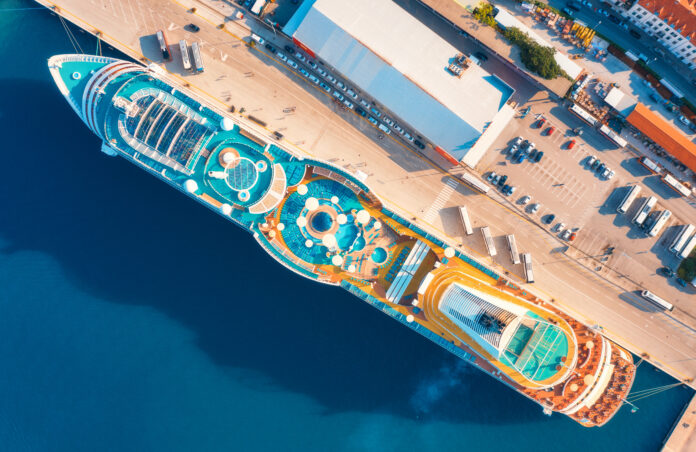
Vacation to plan out during Summer
A cruise ship is an oceangoing vessel that provides passenger-only cruises. It can be used as a floating hotel, with restaurants and shops on board or surrounding waters. They also carry cargo ships, ferries, tugs, barges, and other vessels for their passengers. Most are about 100 meters long, but some have been built to over 400 m in length.
What is a Cruise Vessel?
A cruise liner is a large passenger steamship designed primarily for cruising between ports along with coastal areas. The first modern cruise liners were introduced during World War I when they replaced sailing ships, which had become too vulnerable to enemy attack. Today’s cruise liners are usually around in length and accommodate thousands of passengers at any one time.
How much does it cost to go around the world on a cruise ship?
It costs anywhere from $3,000 to $20,000 per person, depending on how many days/nights you want to spend onboard. Some It cruise depends on companies offering many discounts, so days make you sure want to check to stay out on the board. Different For prices example, before going booking.
Do cruise ships provide food service?
Yes, they offer dining options from casual buffet-style meals to formal sit-down dinners.
Why do people choose to travel by cruise ship?
Because it offers more freedom than traveling by plane, you don’t need to worry about security checks, flight delays, weather conditions, or even getting lost because you know where everything is located. Also, if your luggage gets misplaced while flying, you will not lose anything since all the items are stored inside the cabin.
What is the most popular destination for cruise ships?
The most common destinations include Caribbean islands such as Jamaica, Barbados, St Lucia, Antigua, Aruba, Grand Cayman Island, Cozumel Mexico, Costa Rica, etc., Alaska including Vancouver Canada and San Francisco California, the Bahamas including Nassau New Providence, Bermuda, Europe including London England, France, Italy, Spain, Portugal, Greece, Turkey, Croatia, Egypt, Israel, Morocco, Tunisia, China, Japan, Korea, Taiwan, Australia, New Zealand, India, Indonesia.
What is the most popular cruise destination for U.S. travelers?
Carnival – Florida & Caribbean Islands
Royal Caribbean – Hawaii, Alaska, Pacific Ocean Areas
Norwegian Cruise Line – Caribbean Islands
Celebrity Cruises – Mediterranean Sea Area
Disney Cruise Lines – Caribbean Islands
Princess Cruises – Western Coastline
MSC Cruises – Eastern coastlines
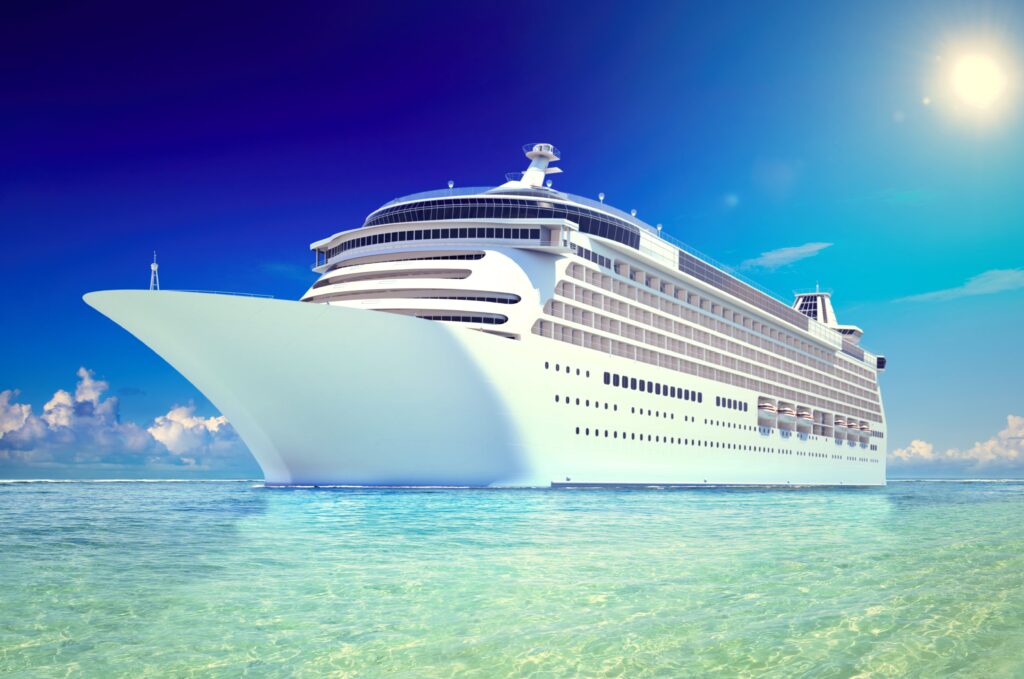
What is the most popular cruise in the world?
Popular cruises worldwide: Carnival Magic, Celebrity Summit
Popular cruises within the U.S.: Carnival Magic, Disney Wonder, Norwegian Epic
Which cruise line has the best reputation?
Holland America Line has the Best Reputation Worldwide.
Which country has the highest number of cruise lines?
The United States of America has the highest number of cruise lines.
Which company owns Royal Caribbean?
RCI Corporation.
Which country has the largest fleet of cruise ships?
Germany has the largest fleet of cruise ships.
Which country has the smallest fleet of cruise ships?
Italy has the smallest fleet of cruise ships.
Which country has the most significant number of cruise lines?
Canada has the most Significant number of cruise lines.
What are the most popular and visited cruise destinations today?
Caribbean Islands
Pacific Northwest
New Zealand
South Africa
North America
People love traveling because you get to see new places and meet new friends! A cruise gives you all those things while having fun doing so! Also, if you’re going on a voyage from your home country, you don’t need to worry about getting sick since everything will be provided for you.
LEAVE A REPLY Cancel reply
Save my name, email, and website in this browser for the next time I comment.
EDITOR PICKS
10 tips on establishing a sophisticated, luxurious home on a budget, 5 easy steps to make your bedroom an inviting place to relax, how to start a successful online business, popular posts, popular category.
- Lifestyle 432
- Home Décor 193
- Finance 141
- Science 122
- Entertainment 48
- affordable decorating ideas 0
Amnesty Media is your news, entertainment, Lifestyle, Health and Fitness website. We provide you with the latest news and videos straight from the industry.
Contact us: [email protected]
- Maritime law
- Shipowners’ Rights and Responsibilities
- Marine Accidents
- Cargo Claims
- Admiralty Claims
- Environmental Law and Maritime Pollution
- Maritime Dispute Resolution
- Cruise Ship Law
Introduction to Cruise Ship Law
Cruise ship law is a body of law that governs the operation of cruise ships. It covers a wide range of topics, including safety, liability, and the rights of passengers.
Table of Contents
What is Cruise Ship Law
Cruise ship law is a complex and ever-evolving field of law. It is based on a combination of international treaties, national laws, and custom.
The main sources of international cruise ship law are the following:
- The International Convention for the Safety of Life at Sea (SOLAS)
- The International Convention on Civil Liability for Oil Pollution Damage (CLC)
- The International Convention on the Limitation of Liability for Maritime Claims (LLMC)
The national laws of each country also play an important role in cruise ship law. These laws may supplement or modify the provisions of international treaties.
Cruise Ship Law for Ship Owners
The ship owner has a number of legal obligations under cruise ship law. These obligations include:
- The obligation to provide a seaworthy vessel : This means that the ship must be fit for its intended purpose and free from any defects that could cause harm to passengers. The ship owner is responsible for inspecting the ship regularly and making any necessary repairs.
- The obligation to exercise due diligence to ensure the safety of passengers : This means that the ship owner must take all reasonable steps to protect passengers from harm. This includes things like providing adequate safety equipment, training crew members on safety procedures, and following all applicable safety regulations .
- The obligation to comply with all applicable safety regulations : This means that the ship owner must comply with all laws and regulations that apply to the operation of cruise ships. These regulations are designed to protect passengers from harm and to prevent accidents.
- The obligation to compensate passengers for any losses or injuries caused by the negligence of the ship owner : This means that the ship owner is liable for any losses or injuries that passengers suffer as a result of the ship owner’s negligence. Negligence can include things like failing to provide a safe vessel, failing to follow safety procedures, or failing to properly train crew members.
Tourist Perspective of Cruise Ship Law
Passengers on cruise ships also have a number of legal rights under cruise ship law. These rights include:
- The right to be safe : Passengers have the right to be safe while on a cruise ship. This means that they have the right to expect that the ship will be seaworthy and that the ship owner will take all reasonable steps to protect them from harm.
- The right to be compensated for any losses or injuries caused by the negligence of the ship owner : Passengers have the right to be compensated for any losses or injuries that they suffer as a result of the ship owner’s negligence. This includes things like medical expenses, lost wages, and pain and suffering.
- The right to be informed of the risks associated with cruising : Passengers have the right to be informed of the risks associated with cruising. This includes things like the possibility of accidents, the possibility of illness, and the potential for natural disasters.
- The right to be treated fairly by the cruise line : Passengers have the right to be treated fairly by the cruise line. This includes things like being given a refund if the cruise is canceled or delayed, being given adequate food and water if the cruise is disrupted, and being protected from discrimination.
Related posts:
- Cruise Ship Passenger Rights and Safety Regulations
- Cruise Ship Contracts: A Legal Perspective
- Legal Perspective of Cruise Ship Accidents and Injuries
- Notable Cruise Ship Legal Cases
Leave a Reply Cancel reply
Your email address will not be published. Required fields are marked *
Save my name, email, and website in this browser for the next time I comment.
Recent Posts
- Balancing Ballast: Legal Considerations in Ballast Water Management
- Balancing the Scales: A Closer Look at Admiralty and Maritime Jurisdiction
- The Tides of Justice: Navigating Through Maritime Litigation
- Safety at Sea: The Legal Backbone of Maritime Operations
- Navigating the Legal Seas: The Operation and Regulation of Jack-Up Barges
Popular posts
- February 2024
- January 2024
- December 2023
- November 2023
- October 2023
- September 2023
- August 2023

The 9 classes of Norwegian Cruise Line ships, explained
MSN has partnered with The Points Guy for our coverage of credit card products. MSN and The Points Guy may receive a commission from card issuers.
Some cruise lines — Viking , for instance — have fleets where many of the ships have the same basic design. Norwegian Cruise Line is not one of them.
If you’re thinking of booking a Norwegian cruise, an important thing to know is that there is a wide variation in the size and style of the vessels in the line’s fleet.
For more cruise guides, news and tips, sign up for TPG’s cruise newsletter .
Four of Norwegian’s 19 ships — Norwegian Escape, Norwegian Bliss, Norwegian Joy and Norwegian Encore — are among the 30 biggest ships in the world. As such, they’re loaded with huge numbers of cabins, restaurants, bars, showrooms and deck-top amusements.
They are, in a nutshell, floating megaresorts .
The line also operates smaller vessels that barely crack the top 100 list of biggest cruise ships. These ships generally have fewer venues and attractions than the bigger ships. However, they still offer a lot for cruisers. Norwegian is a line known for packing oodles of restaurants, bars and entertainment on its vessels — even its smaller ones.
The good news for those of you trying to get a handle on all the options within the Norwegian fleet is that the line’s 19 ships can be bunched into just eight groups of vessels with similar amenities. If you know one member of the group, you know them all.
Each of these groups — known as “classes” in cruise industry lingo — is made up of ships that were constructed around the same time in the same basic design.
Related: Everything to know about cabins and suites on Norwegian ships
An introduction to Norwegian Cruise Line ships
Smaller only than Royal Caribbean , Carnival Cruise Line and MSC Cruises , Norwegian has become increasingly known for some of the biggest, most amenity-filled vessels at sea. As mentioned above, though, the line doesn’t just operate giant ships. More than half its fleet comprises vessels that, by today’s standards, are considered almost midsize.
Indeed, Norwegian is essentially two cruise lines in one. The line’s nine newest ships are big, bustling floating megaresorts that can carry upward of 3,000 to 4,000 passengers at double occupancy (even more with every berth filled). At around 144,000 to nearly 170,000 tons, all nine currently rank among the 50 biggest cruise ships in the world (although their rankings will shift downward as more big ships debut).
Norwegian’s 10 older ships, by contrast, are much more modest in size, measuring around 75,000 to 94,000 tons and carrying closer to 2,000 passengers at double occupancy.
Norwegian thus appeals both to cruisers who like a giant resort vibe and those who prefer a resort experience that is more modest. The key, depending on your tastes, is getting on the right ship in the fleet for you.
On the big-ship end of the spectrum, Norwegian’s four new Breakaway Plus vessels — Norwegian Encore , Norwegian Bliss, Norwegian Joy and Norwegian Escape — are the line’s premier offerings.
One step down in size from the Breakaway Plus ships are the still-quite-large Breakaway-class ships — Norwegian Breakaway and Norwegian Getaway — and the one-of-a-kind Norwegian Epic.
The smallest of the line’s big ships are the recently unveiled Norwegian Viva and Norwegian Prima. They are the first two of a new series of six vessels that will transform the brand. Measuring about 143,500 tons a piece, these two new ships are about 17% smaller than Norwegian’s biggest vessels.
Norwegian’s 10 smaller vessels break down into five classes, though many are roughly the same size and offer similar amenities.
Prima class
Ships in class: Norwegian Prima (2022), Norwegian Viva (2023).
Size: 143,535 tons.
The Prima class of ships is the latest and greatest at Norwegian Cruise Line — the vessels that every NCL fan wants to book.
Only two ships in the series (Norwegian Viva and Norwegian Prima ) are currently in operation. Four more sister vessels are on order for delivery by 2027.
Under development since 2017, these ships mark Norwegian’s first new class of vessel in more than a decade. At 143,535 tons, they are notably smaller than the ships the line has been adding in recent years — a factor that will give them access to smaller ports around the world.
That said, Norwegian Viva, Norwegian Prima and their coming sisters still are relatively big ships that pack a lot of over-the-top amenities. Both Norwegian Viva and Norwegian Prima have ridiculously big go-kart tracks spread over three decks (a cruise industry first). The ships also boast The Drop, a 10-story dry slide that the line says provides more G-force than an accelerating Formula One race car.
Additionally, the vessels each are home to a three-deck theater that converts into a Las Vegas-style nightclub, along with a list of interactive, real-life game shows, including at-sea versions of “The Price Is Right,” “Supermarket Sweep,” “Press Your Luck” and “Beat the Clock.”
Related: I’ve been on nearly every Norwegian ship afloat; here are my first impressions of Norwegian Prima
Still, the new Prima class is about more than flashy entertainment and activities. It marks a more upscale turn for the line. Norwegian Viva and Norwegian Prima offer the largest variety of suite categories (13) for a large ocean ship, the largest three-bedroom suites of any new cruise vessel and the brand’s largest-ever inside, ocean-view and balcony cabins.
The entire back of each of the ships is dedicated to an upscale, “ship-within-a-ship” private suite area called The Haven that rises eight decks high and includes 107 suites, a sprawling private indoor lounge area, private outdoor lounge and pool areas, and a private restaurant. Other vessels feature The Haven areas, but none as big as this one.
In addition, the public areas of Norwegian Viva and Norwegian Prima feel more spacious than many of the other 17 ships in the Norwegian fleet. And, indeed, they are. The Prima-class ships are being built with a higher ratio of space to passengers, which itself is an upscale touch.
Norwegian Cruise Line also says the Prima-class vessels offer the most outdoor deck space of any new cruise ship — including more total pool deck space than any other ships in the brand’s fleet.
Note that the last four ships in the Prima-class series, due to debut between 2025 and 2027, are being redesigned to be bigger than the first two ships in the series.
Related: 11 venues, 32 dishes, four days: See what happened when I tried to test every dish at Prima’s new Indulge Food Hall
Breakaway Plus class
Ships in class: Norwegian Encore (2019), Norwegian Bliss (2018), Norwegian Joy (2017), Norwegian Escape (2015).
Size: 164,600 to 169,145 tons.
These are the Norwegian ships you go on if you’re a fan of megaresorts.
While not quite as big as Royal Caribbean’s giant Oasis-class ships , Norwegian’s Breakaway Plus-class vessels are firmly in the pantheon of the world’s cruising giants. They are the Norwegian ships most packed with restaurants, bars, entertainment and over-the-top attractions. There are so many of these things that you won’t be able to do it all in a single, weeklong cruise.
The Breakaway Plus ships are so big, in fact, that they have room for giant go-kart tracks and laser tag areas on their top decks (on all of the vessels in the series except Norwegian Escape). There’s also plenty of room to spare for multiple pools, waterslides and a kiddie splash zone.
Each of the vessels also offers real Broadway shows in big, state-of-the-art theaters, sprawling spas, casinos that fill half a deck, dedicated children’s play zones, and more than 2,000 rooms.
In addition, the two newest ships in this series, Norwegian Encore and Norwegian Joy, have large gaming and virtual reality zones called the Galaxy Pavilion.
For meals, you’ll find at least 20 venues on each of these ships, including multiple main dining rooms and a buffet that come with no extra charge and such extra-charge eateries as a teppanyaki restaurant, a steakhouse, a high-end French restaurant and a Jimmy Buffett’s Margaritaville at Sea.
With lots of family-friendly attractions such as the go-kart tracks and laser tag courses, these ships appeal heavily to families with children, particularly teens, but they draw a lot of couples, too. They are also popular with solo travelers, thanks to their unusually large complexes of cabins for one (something you’ll find on the Breakaway and Epic classes of ships, too).
Related: The ultimate guide to Norwegian’s Latitudes Rewards loyalty program
All four of the Breakaway Plus ships have large, private, two-deck-high suite enclaves called The Haven that come with their own pool areas, restaurants and lounges. They’re some of the most spectacular suite complexes anywhere at sea .
The biggest of these ships, Norwegian Encore, measures 169,116 tons, making it the 18th-biggest cruise ship in the world as of this story’s publishing (it will drop in the rankings over the coming years as additional megaships debut). That’s bigger than all but one Carnival ship and every Princess Cruises ship. Only Royal Caribbean and MSC Cruises have a significant number of bigger vessels.
Norwegian Encore can hold more than 5,000 passengers with all berths filled.
Breakaway class
Ships in class: Norwegian Getaway (2014), Norwegian Breakaway (2013).
Size: 145,655 tons.
These vessels are similar to the Breakaway Plus-class ships but slightly smaller. Or, put another way, the Breakaway Plus-class ships are a stretched version of the Breakaway-class ships.
You’ll find many of the same eateries, bars, lounges and entertainment venues on the Breakaway-class ships that you’ll find on the Breakaway Plus-class vessels. The slightly smaller size of these vessels means there’s just a tad less “stuff” on board.
The top decks of the Breakaway-class ships have two pool areas and water parks with waterslides, for instance — just like the Breakaway Plus-class ships. However, they don’t have go-kart tracks or laser tag courses. Instead of the latter attractions, you’ll find an adults-only pool area called Spice H2O at the back of the vessels. At night, it transforms into a dance club.
Related: Every Norwegian Cruise Line ship ranked from biggest to smallest
The Breakaway-class ships also boast full-size ropes courses on their top decks. Indeed, they were the first cruise ships ever to have such a feature. Other deck-top features include miniature golf courses on both vessels and basketball courts that double as volleyball courts.
On the entertainment front, both ships offer Broadway shows in their main theaters and have a circuslike show in a secondary theater called “Cirque Dreams.” The latter is a dinner show that comes with an extra charge. They’re also home to “Howl at the Moon” dueling piano shows and a version of the Latin-themed dance show “Burn the Floor.”
Like the Breakaway Plus vessels, the Breakaway ships have large complexes for solo travelers, as well as large, private The Haven suite complexes.
In general, as with the Breakaway Plus ships, these vessels are best for vacationers who like a megaresort-type experience, and they appeal heavily to families with children who love all their deck-top attractions. Each of the two ships in this series — Norwegian Breakaway and Norwegian Getaway — holds about 4,000 passengers at double occupancy.
Related: The 5 best destinations you can visit on a Norwegian ship
Ships in class: Norwegian Epic (2010).
Size: 155,873 tons.
Norwegian Epic is an outlier in the Norwegian fleet. Unveiled in 2010, it was originally supposed to be the first of a series of up to three similar vessels. However, after disagreements with the shipyard that built it, Norwegian eventually canceled an order for a second ship in the series and an option for a third ship in the series, leaving Norwegian Epic in a class of one.
While roughly comparable in size to the Breakaway Plus- and Breakaway-class ships (it’s a bit smaller than the former vessels and a bit bigger than the latter vessels), Norwegian Epic has a notably different design that includes some unique features.
Perhaps most notably, balcony cabins on the ship have an unusual design that includes curved walls, rounded bed corners, and a sink and vanity area that is in the main living space (for all to see), separate from a closed-off toilet area. The toilet area is behind a translucent door that some cruisers find less private than they had hoped.
Norwegian Epic is also home to the only tube-and-bowl waterslide at sea and has such rare-for-cruise-ships attractions as a rappelling wall and a three-lane bowling alley. It also features an ice bar where customers wear parkas while sipping drinks.
Still, Norwegian Epic also offers a lot that will be familiar to Norwegian fans, including many of the line’s signature restaurants, bars and entertainment.
Standout features on Norwegian Epic include a water park with some of the most over-the-top waterslides at sea (including the aforementioned tube-and-bowl slide). It also offers a version of the Burn the Floor dance show that played on Broadway and on the West End in London, as well as a Howl at the Moon piano bar and a recreation of the Cavern Club nightspot in Liverpool, England, where The Beatles got their start (complete with a The Beatles cover band).
In addition, Norwegian Epic has the line’s biggest solo cabin complex (with 128 rooms for one) and a giant The Haven private suite complex.
At 155,873 tons, Norwegian Epic currently ranks as the 34th biggest cruise vessel in the world. Notably, it was the world’s third-largest ship when it debuted in 2010. That tells you just how much the cruise industry has grown in recent years.
Norwegian Epic carries 4,100 passengers at double occupancy.
Jewel class
Ships in class: Norwegian Gem (2007), Norwegian Jade (2006), Norwegian Pearl (2006), Norwegian Jewel (2005).
Size: About 93,500 tons.
Are you unsure if you want to sail on a megaship with 4,000 or more people but still want a vessel with a good amount of features and activities? The Jewel-class ships may be the perfect solution.
At 93,500 tons, the four vessels in the series are nearly 50% smaller than the line’s Breakaway Plus-class ships but still big enough that they have a lot to offer.
Each of the vessels has more than a dozen food venues, including three main restaurants, a casual buffet, a steakhouse, a French restaurant and a teppanyaki eatery.
You’ll also find multiple pools on each of the ships, along with whirlpools, basketball courts and golf driving nets. Each of the ships also has a theater, spa, casino, and multiple bars and lounges.
What you won’t find on the ships, because of their smaller size, are all the gee-whiz attractions such as go-kart tracks, laser tag courses and large water-park areas that Norwegian has put on its bigger vessels. If you can’t live without those sorts of features on a cruise ship, then the Jewel class probably isn’t for you.
Note that Norwegian Gem does have a climbing wall and a single waterslide. Norwegian Pearl has a climbing wall but no waterslide. Norwegian Jewel and Norwegian Jade have neither of the attractions.
Related: Norwegian Cruise Line ships listed from newest to oldest
Each of the Jewel-class ships holds around 2,400 passengers at double occupancy (plus a few hundred more with every berth filled). That’s about 40% fewer passengers than you’ll find on the biggest Norwegian ships.
That makes them perfect for cruisers who want to get away from the sort of crowds that are on the biggest megaships without giving up many of the amenities that big ships have to offer.
Pride of America class
Ships in class: Pride of America (2005).
Size: 80,439 tons.
Like Norwegian Epic, Pride of America is an outlier in the Norwegian fleet. In fact, it’s perhaps an even bigger outlier than the former vessel.
Sporting a patriotic U.S. theme (you’ll find venues named after Thomas Jefferson and John Adams) and a distinct array of lounges and entertainment, it’s a ship specifically designed to sail year-round in Hawaii — the only one of its kind at any line.
Pride of America notably flies a U.S. flag and operates with a mostly U.S. crew, in keeping with regulations governing cruise itineraries that only include U.S. ports. That’s a big difference from any other big cruise vessel in the world.
Related: The best Hawaii cruises for every type of traveler
It’s also the only Norwegian vessel without a casino, in keeping with local Hawaii regulations.
If you sail on Pride of America, you’ll find such one-of-a-kind eateries as the classic American car-themed Cadillac Diner. You’ll also find some of Norwegian’s signature offerings, including a Cagney’s steak house and Italian eatery La Cucina. The ship’s other onboard attractions include a showroom, lounges, bars and a top deck with extensive open-air pool and sun lounging areas.
Thanks to its ownership of Pride of America, Norwegian is the undisputed leader in Hawaii cruises. Most cruise lines that offer sailings to Hawaii only offer a limited number of such trips during a few months each year. Norwegian, by contrast, offers sailings around the Hawaiian Islands every week of the year — the only cruise line in the world to do so.
An iconic presence in Hawaii, Pride of America has been permanently dedicated to the archipelago since its debut in 2005. It offers a repeating seven-night itinerary that begins each Saturday in Honolulu and brings the chance to visit four different Hawaiian islands on a single, seven-night trip.
Beginning and ending on the island of Oahu, the itinerary includes two days each on Maui, Kauai and Hawaii. The two-day visit to Maui involves an overnight stay at the port of Kahului. The two-day visit to Kauai involves an overnight stay at the port of Nawiliwili. The two-day visit to Hawaii is split between a call at Hilo and a call at Kona.
Ships in class: Norwegian Dawn (2002), Norwegian Star (2001).
Size: 92,250 and 91,740 tons.
The Dawn-class ships are similar to the Jewel-class ships in size and amenities, with a few differences.
Like the former vessels, the Dawn-class ships have around a dozen food-serving venues, including three main restaurants, a casual buffet, a Brazilian churrascaria (barbecue) restaurant, a French restaurant and a teppanyaki eatery.
You’ll also find multiple pools on each of the ships, whirlpools, basketball courts and golf driving nets. Each of the ships also has a theater, spa, casino, and multiple bars and lounges.
Like the Jewel-class ships, the Dawn-class vessels lack the sort of big attractions such as go-kart tracks and large water parks found on bigger Norwegian vessels. In addition, there are no Broadway musicals on Dawn-class ships, and they don’t have a private The Haven suite area (though they do have several giant suites called Garden Villas that measure more than 6,000 square feet).
If you can’t live without those sorts of features on a cruise ship, then the Dawn class probably isn’t for you.
Ships in class: Norwegian Sun (2001), Norwegian Sky (1999).
Size: 78,309 and 77,104 tons.
Dating to 2001 and 1999, respectively, Norwegian Sun and Norwegian Sky are among the smallest ships at Norwegian. They offer fewer onboard attractions and amenities than is typical for the line’s vessels.
In general, they appeal to cruisers looking for a more intimate experience on a cruise ship than what you’ll find on the big Norwegian ships. They also draw cruisers who care more about the destinations that they visit on a cruise than onboard attractions.
On each of the vessels, you’ll find more than half a dozen eateries, including several main dining rooms, a casual buffet, a diner-style pub, a steakhouse, an Italian trattoria and a French bistro.
On their top decks, the ships have pools (one on Sun, two on Sky), whirlpools, a basketball court that doubles as a volleyball court, golf driving nets and a jogging track. The ships also have casinos and theaters with nightly shows.
Unlike most bigger Norwegian ships, neither of the vessels has a private The Haven suite complex or solo cabins.
Ships in class: Norwegian Spirit (1998).
Size: 75,904 tons.
Dating to 1998, Norwegian Spirit is Norwegian’s smallest and oldest ship, and — like the line’s Sun-class ships — it generally appeals to cruisers looking for a more intimate experience than you’ll find on the big Norwegian ships.
At 75,904 tons, Norwegian Spirit is less than half the size of Norwegian’s biggest ships, and it carries just 1,966 passengers — more than 2,000 fewer than the Norwegian biggies.
It also offers fewer (but still quite a few) venues and attractions. In all, you’ll find 13 food outlets on board, including two main restaurants, a casual buffet eatery, and versions of the line’s signature Cagney’s steakhouse and French eatery Le Bistro. There are more than half a dozen bars and cafes.
Deck-top attractions include several pools, whirlpools, waterslides, a basketball court and a jogging track. The ship also has a casino, spa, nightclub and theater.
Of note, Norwegian Spirit originally was built for Asia-based Star Cruises (where it was called SuperStar Leo).
Planning a cruise? Start with these stories:
- The 5 most desirable cabin locations on any cruise ship
- The 8 worst cabin locations on any cruise ship
- A quick guide to the most popular cruise lines
- 21 tips and tricks that will make your cruise go smoothly
- 15 ways cruisers waste money
- 15 best cruise ships for people who never want to grow up
- What to pack for your 1st cruise
SPONSORED: With states reopening, enjoying a meal from a restaurant no longer just means curbside pickup.
And when you do spend on dining, you should use a credit card that will maximize your rewards and potentially even score special discounts. Thanks to temporary card bonuses and changes due to coronavirus, you may even be able to score a meal at your favorite restaurant for free.
These are the best credit cards for dining out, taking out, and ordering in to maximize every meal purchase.
Editorial Disclaimer: Opinions expressed here are the author’s alone, not those of any bank, credit card issuer, airlines or hotel chain, and have not been reviewed, approved or otherwise endorsed by any of these entities.
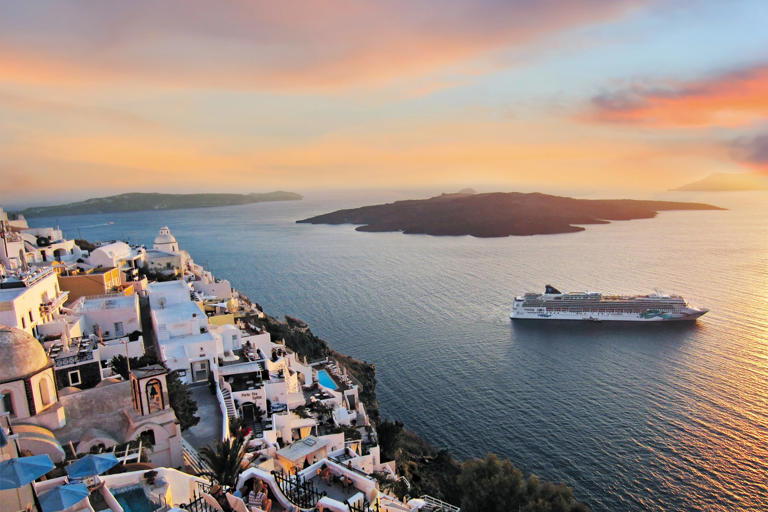
Winter is here! Check out the winter wonderlands at these 5 amazing winter destinations in Montana
- Plan Your Trip
What’s It Like To Actually Work On A Cruise Ship?
Published: October 11, 2023
Modified: December 28, 2023
by Perrine Kelsey
Introduction
Working on a cruise ship is often considered a dream job for many people. The idea of traveling the world, meeting new people, and enjoying the luxuries of a floating resort is undoubtedly enticing. However, the reality of working on a cruise ship is not always as glamorous as it may seem from the outside.
Life on board a cruise ship is a unique experience, quite different from a regular 9-to-5 job on land. It requires a certain level of adaptability, flexibility, and dedication to thrive in this environment. From long work hours to shared living spaces, there are several aspects that make working on a cruise ship different from any other job.
In this article, we will take a closer look at what it’s really like to work on a cruise ship. We’ll explore the various job positions and responsibilities, the work schedule and hours, the challenges and benefits, and the social life and career opportunities available on board.
Whether you are considering a career on a cruise ship or simply intrigued by what goes on behind the scenes, this article will provide you with valuable insights into the fascinating world of cruise ship employment.
Life on Board a Cruise Ship
Life on board a cruise ship is a dynamic and ever-changing experience. It is a microcosm of its own, with a diverse mix of crew members and guests from different cultures and backgrounds. The ship becomes your home, workplace, and community all rolled into one.
Living quarters on a cruise ship are typically compact and shared with fellow crew members. You may have a cabin mate or even several roommates, depending on your position. Personal space is limited, but crew members quickly adapt to the close quarters and learn to make the most of it.
Meals are usually provided for crew members in designated crew areas. The food is often varied and of high quality, catering to different dietary preferences. However, dining times may be limited due to the demanding nature of work on a ship, and you will need to accommodate your meal breaks accordingly.
One of the unique aspects of working on a cruise ship is the constant change in scenery. As the ship sails from one destination to another, you have the opportunity to explore various ports of call. During your time off, you can go ashore and immerse yourself in the local culture, try new cuisines, and visit attractions. It’s like having a mini vacation every time the ship docks at a new port.
However, it’s important to note that while you may get glimpses of exotic destinations, your primary focus will be on your work responsibilities. The work environment on a cruise ship can be demanding and fast-paced, requiring you to be efficient and attentive to guest needs. But don’t worry, there are also designated crew-only areas where you can relax and unwind during your downtime.
Overall, life on board a cruise ship offers a unique blend of work and travel. It’s an opportunity to see the world, gain valuable work experience, and form lifelong friendships with people from diverse backgrounds.
Job Positions and Responsibilities
Cruise ships are like floating cities, requiring a wide range of staff to ensure smooth operations and an enjoyable experience for guests. From deckhands to entertainers, there are various job positions available on board with distinct responsibilities.
One of the most common job positions on a cruise ship is that of a cabin steward or housekeeper. They are responsible for maintaining the cleanliness and orderliness of guest cabins, as well as providing excellent service to ensure guest satisfaction. They attend to requests, restock supplies, and ensure that cabins are ready for new guests.
Retail staff are another integral part of the cruise ship team. They work in onboard shops and are responsible for assisting guests with their shopping needs, promoting merchandise, and handling transactions. They need to have a good knowledge of the products available and be able to provide exceptional customer service.
Food and beverage staff play a crucial role in the dining experience on board. From waiters and bartenders to chefs and kitchen staff, they ensure that guests’ culinary needs are met. They take orders, serve meals, mix drinks, and maintain cleanliness in the dining areas.
The entertainment department is responsible for keeping guests entertained throughout their cruise. This includes performers such as singers, dancers, musicians, and comedians, as well as activity coordinators who organize games, events, and parties to engage guests and create memorable experiences.
In addition to these positions, there are also engineering and technical staff who keep the ship running smoothly behind the scenes. They are responsible for maintaining and repairing machinery, electrical systems, and other technical aspects of the ship.
It’s important to note that the responsibilities and job positions may vary depending on the size and type of cruise ship. Larger ships may have a wider range of positions, including specialized roles in areas such as spa services, childcare, and guest services.
Regardless of the job position, working on a cruise ship requires a strong work ethic, excellent customer service skills, and the ability to adapt to a multicultural environment. Each role plays a vital part in creating a positive guest experience and ensuring the smooth operation of the ship.
Work Schedule and Hours
Working on a cruise ship entails a different schedule and set of working hours compared to traditional land-based jobs. The nature of the industry requires round-the-clock operations to cater to the needs of guests. This means that crew members work in shifts, often with long hours and limited time off.
The work schedule on a cruise ship can vary depending on the department and position. Some departments, such as housekeeping and food and beverage, may require working in split shifts to accommodate the various meal times and guest needs. This means that crew members may have early morning or late-night shifts, with breaks in between to rest.
Crew members generally work seven days a week, with contracts lasting for several months at a time. The specific work hours can range from 8 to 12 hours per day, sometimes even longer during peak times. However, it’s important to note that cruise lines are required to adhere to certain regulations regarding crew working hours and rest periods.
While the work schedule can be demanding, many crew members find ways to maintain a work-life balance. They make the most of their time off by exploring the ship’s amenities, socializing with colleagues, engaging in recreational activities, or simply relaxing and enjoying some downtime. Cruise ships often have designated crew areas where crew members can unwind and socialize during their free time.
It’s important to have a clear understanding of the work schedule and hours before committing to a job on a cruise ship. The nature of the industry requires dedication and flexibility, as you may be required to work holidays, weekends, and odd hours. However, many crew members find the experience rewarding and enjoy the unique lifestyle that comes with working on a cruise ship.
Challenges of Working on a Cruise Ship
While working on a cruise ship can be an exciting and rewarding experience, it’s important to recognize that it also comes with its fair share of challenges. It’s not all smooth sailing, and adjusting to life on board can be a significant adjustment for many crew members.
One of the main challenges of working on a cruise ship is being away from family and friends for extended periods. Contracts can last for several months, meaning you may miss important events and special occasions back home. This can lead to feelings of homesickness and a sense of isolation.
The work environment on a cruise ship can also be demanding and fast-paced. Crew members are expected to provide exceptional customer service, often dealing with demanding guests and high-pressure situations. Working long hours, sometimes without days off, can take a toll on physical and mental well-being.
Living in shared quarters with limited personal space can be another challenge. It can be difficult to have privacy and downtime when living in close proximity to colleagues. Adjusting to this communal living arrangement requires patience, adaptability, and respect for others’ boundaries.
Another challenge is the potential for seasickness. While modern cruise ships are equipped with stabilizers to minimize rocking, some crew members may still experience seasickness, especially during rough sea conditions. It can be particularly challenging for crew members who work in roles that require them to be on their feet for long periods.
Lastly, cultural differences and language barriers can present challenges in communication and understanding. Cruise ships are multicultural environments, with crew members and guests from all around the world. It’s important to be open-minded, respectful, and patient while interacting with people from different backgrounds and cultures.
Despite these challenges, many crew members find ways to overcome them and thrive in their roles. The experience of working on a cruise ship can be transformative, offering opportunities for personal and professional growth, as well as the chance to travel and experience new cultures.
Benefits of Working on a Cruise Ship
Working on a cruise ship offers a range of unique benefits that make it an attractive career choice for many individuals. While the challenges may be present, there are numerous advantages that come with this line of work.
One of the most notable benefits is the opportunity to travel the world. Cruise ships visit multiple destinations, allowing crew members to explore various countries and experience different cultures. From stunning beaches to historic landmarks, crew members have the chance to see and appreciate the beauty of different parts of the globe.
Another significant benefit is the ability to save money. Accommodation, meals, and most expenses are covered while working on a cruise ship. This allows crew members to save a significant portion of their earnings, as they don’t have to worry about rent, utility bills, or grocery expenses. It can be a great way to save for future goals or financial stability.
Working on a cruise ship also offers the opportunity for personal growth and development. Interacting with guests and colleagues from diverse backgrounds helps to broaden cultural understanding and communication skills. The experience of working in a fast-paced, customer-focused environment enhances problem-solving abilities and adaptability.
Career advancement is another advantage of working on a cruise ship. Many cruise lines provide opportunities for growth and promotion within the company. With dedication, hard work, and the right skills, crew members can progress in their career and take on positions of greater responsibility.
Additionally, cruise ship employment often comes with perks and discounts. Crew members may have access to onboard amenities such as gyms, movie theaters, and crew bars. They may also enjoy discounts on select services, excursions, and even travel opportunities during their time off the ship.
Finally, working on a cruise ship can be a socially fulfilling experience. Living and working in close proximity with colleagues from all over the world can lead to lifelong friendships. The shared experiences and camaraderie built on board can create a unique bond among crew members.
It’s important to note that the benefits may vary depending on the cruise line and position. The size of the ship, its itinerary, and the company’s policies can all influence specific advantages available to crew members.
Overall, the benefits of working on a cruise ship go beyond just a paycheck. It offers the chance to explore the world, save money, develop skills, and form lasting relationships. It’s an opportunity for personal and professional growth while enjoying a unique and rewarding lifestyle.
Social Life and Recreation
Working on a cruise ship offers a vibrant and active social life, providing opportunities for crew members to form friendships, engage in recreational activities, and create lasting memories.
One of the highlights of working on a cruise ship is the multicultural environment. Crew members come from all corners of the globe, bringing with them their unique cultures, traditions, and perspectives. This diversity fosters an environment of cultural exchange and learning, allowing crew members to broaden their horizons and develop a global network of friends.
Onboard social activities and events are organized to promote camaraderie among crew members. From themed parties and karaoke nights to sports tournaments and talent shows, there are numerous opportunities for crew members to come together and have fun. These events not only provide a break from work but also create a sense of community and belonging.
Recreational facilities on cruise ships are well-equipped to cater to various interests and hobbies. Crew members can make use of gyms, swimming pools, sports courts, and even dedicated crew bars and lounges. These spaces serve as areas to relax, unwind, and socialize during downtime.
In addition to onboard activities, crew members have the chance to explore ports of call during their time off. Depending on the ship’s itinerary, they can engage in various shore excursions and visit local attractions. Whether it’s snorkeling in the Caribbean, exploring ancient ruins in Europe, or shopping in vibrant markets in Asia, crew members have the opportunity to experience different destinations and create memorable experiences.
The social life on a cruise ship extends beyond the confines of the ship itself. Many crew members establish long-lasting friendships, and when they have time off, they may explore ports of call together or plan group activities ashore. These connections often transcend the duration of a contract and can result in lifelong bonds.
However, it’s important to strike a balance between work and social life on board. While it can be tempting to indulge in the social aspects, it’s crucial to maintain professionalism and fulfill work responsibilities diligently. Crew members must understand the boundaries between work and leisure time to ensure a harmonious and productive work environment.
The social life and recreational activities available on a cruise ship contribute to the overall experience and make it more than just a job. It provides a platform to forge connections, create lasting memories, and embrace a sense of community while exploring the world.
Career Opportunities and Advancement
Working on a cruise ship offers not only a unique experience but also a range of career opportunities and the potential for advancement within the industry. Cruise lines are constantly seeking talented individuals who can excel in their roles and contribute to the success of the company.
One of the advantages of working on a cruise ship is the exposure to different departments and job functions. Starting in an entry-level position allows crew members to gain valuable experience and develop a solid foundation in the industry. As they prove their skills and dedication, they may have the opportunity to take on more responsibility and move up the ladder.
Cruise lines often have structured career development programs and training initiatives in place, providing crew members with opportunities for growth and advancement. These programs may include specialized training, mentorship programs, and performance evaluations to identify and nurture high-potential individuals.
The size and diversity of cruise ships also offer a multitude of career paths to explore. Whether it’s progressing from a cabin steward to a housekeeping supervisor, or transitioning from a server to a restaurant manager, there are opportunities for advancement within specific departments. Additionally, cross-departmental moves are possible, allowing crew members to diversify their skillsets and gain a broader understanding of ship operations.
Cruise lines also value loyalty and dedication. Crew members who demonstrate commitment, consistent performance, and a positive attitude are more likely to be considered for promotions and higher positions. Longevity within a particular cruise line can open doors to managerial roles, executive positions, or even opportunities within shoreside offices.
Furthermore, the experience gained from working on a cruise ship is highly transferable to other sectors of the hospitality and travel industry. The skills and knowledge acquired, such as customer service, teamwork, problem-solving, and cultural competence, are applicable in various professional settings. This means that even if crew members decide to transition to land-based jobs, their experience on a cruise ship can provide a competitive edge.
It’s important for crew members interested in advancing their careers on a cruise ship to be proactive, seek out opportunities for learning and development, and demonstrate their commitment to continuous improvement. By taking advantage of the resources and programs offered by the cruise line, crew members can pave the way for growth and advancement within the industry.
The cruise industry continues to expand, providing a wealth of career opportunities for individuals seeking a challenging and rewarding professional path. Whether it’s advancing within a specific department or exploring new horizons, working on a cruise ship can offer a promising and fulfilling career trajectory.
Working on a cruise ship is a unique and multifaceted experience that offers a blend of adventure, personal growth, and career opportunities. While it comes with its own set of challenges, the benefits and rewards can outweigh the difficulties for those who are passionate about travel, cultural exchange, and providing exceptional service in a dynamic environment.
Life on board a cruise ship presents opportunities for exploration and learning. Crew members have the chance to visit numerous destinations, immerse themselves in different cultures, and expand their horizons. The camaraderie among crew members from around the world creates a supportive community that often lasts beyond their time on board the ship.
Working on a cruise ship also provides a unique lifestyle that allows crew members to save money, gain valuable work experience, and develop transferable skills. The industry offers career advancement opportunities, with structured training and the chance to move up in various departments.
However, it’s important to be aware of the challenges that come with working on a cruise ship. Being away from family and friends for extended periods, adjusting to communal living, and working long hours can be demanding. Flexibility, adaptability, and a positive mindset are essential qualities for success in this industry.
In conclusion, working on a cruise ship offers a remarkable and fulfilling experience for those who are willing to embrace the adventure and thrive in a multicultural environment. It provides an opportunity to combine work and travel, meet new people, and create lasting memories. From the thrill of exploring new destinations to the sense of satisfaction from providing excellent service, working on a cruise ship can be a truly rewarding career choice.

- Privacy Overview
- Strictly Necessary Cookies
This website uses cookies so that we can provide you with the best user experience possible. Cookie information is stored in your browser and performs functions such as recognising you when you return to our website and helping our team to understand which sections of the website you find most interesting and useful.
Strictly Necessary Cookie should be enabled at all times so that we can save your preferences for cookie settings.
If you disable this cookie, we will not be able to save your preferences. This means that every time you visit this website you will need to enable or disable cookies again.

- Cruise News
Alaska Cruise Port Will Enforce Passenger Limits Starting in 2026

Andrea Santillan
- April 5, 2024
During Juneau’s last cruising season, a record-breaking 1.6 million cruise ship passengers visited the Alaskan capital.
But how will the introduction of cruise passenger limits affect its ability to welcome guests?
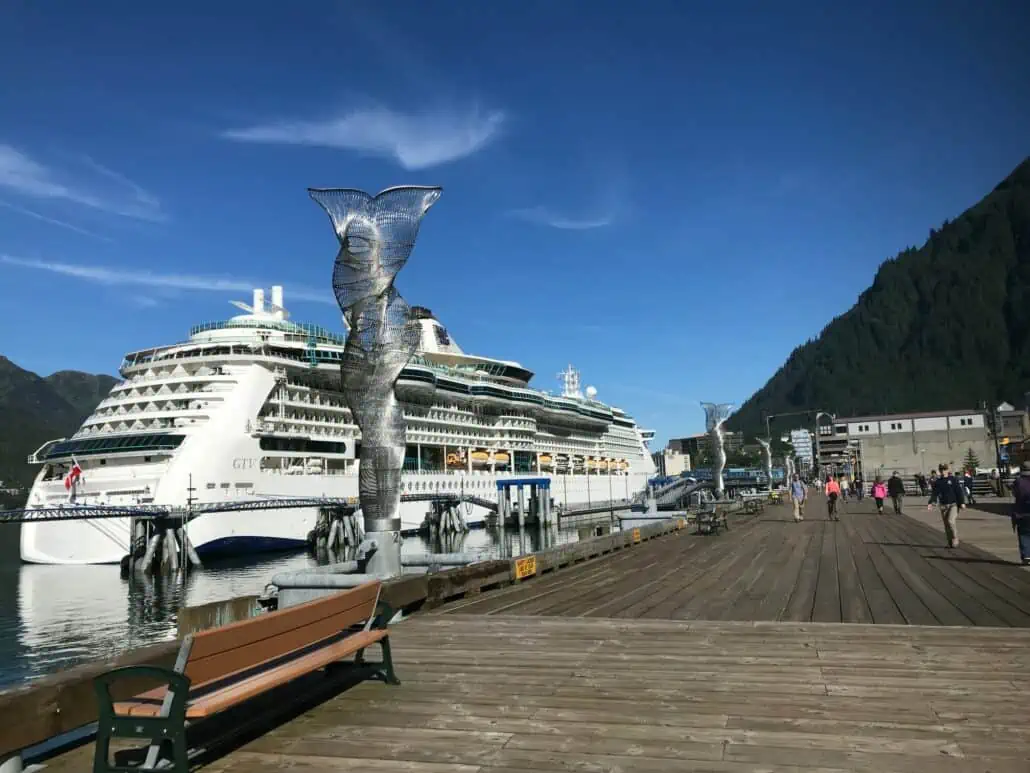
According to Juneau Tourism Manager Alix Pierce, there are no hard numbers yet. However, Pierce is optimistic since cruise lines have already committed to a conceptual agreement that places a cap on the number of daily passengers.
She added that once the agreement is finalized and approved, it will be implemented in 2026.
Aside from reducing the number of cruise ship passengers, Pierce shared that local officials are trying to make Saturday the least congested day of the week for Juneau.
Local authorities are also using the negotiations to discuss issues the city has been experiencing regarding congestion and hot berthing (when a cruise ship leaves and is replaced by another on the same day).
Alaska’s other attempts to regulate the cruise industry

Last year, Juneau succeeded in introducing a 5-per-day limit on large cruise ships . In February 2024, the city announced that it was able to radically reduce cruise ship trash from 2019 to 2023 by 92%.
However, not all of Alaska’s attempts to regulate the cruise industry have flourished. In 2023, a resident also tried to impose a limit on the number of cruise guests that Sitka could host. From 560,000 cruise ship visitors, it proposed to introduce a cap of only 240,000 passengers per cruising season. The proposal was rejected by the city last October.
Juneau made a similar move to significantly regulate cruise ship passengers in 2021, but it failed because it wasn’t able to gather enough signatures.
According to a 2023 Economic Impact report , Juneau received over $22 million in revenues associated with cruise ships in 2023.
Recent Posts
Sun princess christened in barcelona by hannah waddingham, princess cruises [photos], construction starts for royal caribbean’s private beach club in nassau, princess introduces new sanctuary collection on sun princess and star princess, norwegian’s next cruise ship floated out at shipyard, share this post, related posts.
![cruise ship introduction Sun Princess Christened in Barcelona by Hannah Waddingham, Princess Cruises [PHOTOS]](https://cruiseradio.net/wp-content/uploads/2024/04/Sun-Princess-Christening-6-300x169.jpg)
MSC and Mercy Ships To Build State-of-the-Art Hospital Vessel

New Consumer Law Mandates Clear Pricing for Cruise Lines

Bringing you 15 years of cruise industry experience. Cruise Radio prioritizes well-balanced cruise news coverage and accurate reporting, paired with ship reviews and tips.
Quick links
Cruise Radio, LLC © Copyright 2009-2024 | Website Designed By Insider Perks, Inc
- Share full article
Advertisement
Supported by
Welcome to Venice. That’ll Be 5 Euros, Please.
Venice’s first day of charging a fee to enter the historic center went mostly smoothly, but there were some protests and polemics.

By Elisabetta Povoledo
Reporting from Venice
Pulling into the Santa Lucia train station in Venice on Thursday morning, passengers were told via an overhead announcement that they might have to pay a 5-euro fee to enter the city’s historic center. Failure to pay could result in a fine from 50 to 300 euros, the announcement said.
Outside the station, police officers in riot gear lingered, while a flock of assistants in colorful safety vests stopped arriving travelers to ensure that they had a QR code indicating that they had registered to visit on a city website. Those who hadn’t were directed to a booth where they could. After registering, overnight visitors were sent on their way without having to pay, but people planning to stay just for the day were charged (though there were other exemptions ).
It was a new welcome to Venice, the first city in the world to charge day visitors a nominal entrance fee, a measure city officials hope will help counter overtourism.
“I only found out because my partner texted me this morning to say it was happening,” said Lorraine Colcher, a hospital administrator from Wirral, England, in line at the booth. “I thought he was joking.”
And she didn’t think that people should have to pay for the privilege of seeing a “beautiful city that everyone wants to visit,” she said.
Not far from the station, hundreds of protesters were making a lot of noise. For them, charging an entrance fee was a worrisome step in bringing Venice closer to what many fear the city will become if tides don’t turn: a theme park. Blowing whistles, they handed out fake tickets reading, “Welcome to Veniceland.” Some held signs saying, “Venice is not for sale” and “Stick It to the Ticket,” and chanted, “We want to take back our city.”
“A ticket doesn’t resolve overtourism,” said Renata Marzari, a retired teacher from Venice who was among the protesters.
Like other locals, she acknowledged that an influx of tourists — which last year reached nearly 20 million — could be a challenge. Often, she said, it involved physical collisions, including “pointing accidents, when you walk into a suddenly raised hand, or photo accidents, when they back into you as they’re looking into their phones.” But the ticket, which applies only to day visitors arriving between 8:30 a.m. to 4 p.m., was “ridiculous,” she said. She added, “They could make more money charging for every cigarette butt that gets tossed on the ground.”
Venice is only one of dozens of cities, including Amsterdam, Athens and Barcelona, grappling with a glut of tourists. Speaking in front of the train station Thursday morning, the city’s mayor, Luigi Brugnaro, said he had been contacted by other places interested in the initiative, but he wouldn’t say which ones, “for reasons of confidentiality.”
Floating on water crisscrossed with canals, Venice, which tradition says was founded in 421, though that date is debated, is exceptionally fragile. Last year experts at UNESCO, the United Nations’ culture agency, recommended it be put on the list of its endangered World Heritage Sites, listing mass tourism as a main concern. Venice stayed off the “in danger” list after the access fee was approved, but UNESCO officials said in a statement that “further progress still needs to be made.”
Critics of the fee say that it will do little to combat the city’s real problems, which have pushed many to leave. The resident population in the city center has eroded to fewer than 49,000 people, from nearly 175,000 in 1951, according to municipal statistics . They list a lack of affordable housing, because of short-term rentals; a decline in services like schools and transportation; and the encroachment of the tourist industry into practically all walks of life.
Federica Toninelli, a member of a local association that advocates affordable housing in Venice, saw the ticket as “propaganda” and said the city must put “the needs of residents at the center of policies.” City officials need to “take strong steps that would bring the city back to a level of more manageable tourism,” she said.
Otherwise, “this is how a city dies,” said Nicola Camatti, an economics professor and expert in tourism at Ca’ Foscari University of Venice.
Franca Caltarossa, who once ran a municipal after-school program that she said lost much of its funding under the current mayor, said that “tourism has distorted the city.”
“Venice is a living city, not a theme park,” she said.
A 2020 study by tourism experts at Ca’ Foscari, Venice’s main university, suggested that the optimum number of visitors to Venice per day was around 52,000 people, about a quarter of them daily excursionists. But Venice is not capping the number of visitors.
“We are contrary to limiting the number of visitors; this is an open city,” said Michele Zuin, the city councilor in charge of the budget. Instead, the city hoped that day visitors — around 10 million last year — would plan to come on off-peak days when the city “is calmer,” Mr. Zuin said.
“We’re convinced that it is a solution to manage day visitors,” he said.
On Thursday, a national holiday in Italy, 113,000 people had registered to enter Venice. Of these, 15,700 paid the access fee and 40,000 were exempt overnight guests, while the remaining visitors — also exempt — included students, workers and relatives or friends of residents.
For 2024, the fee will be applied on 29 peak days as “an experiment,” Mr. Zuin said. Data collected during this phase will help city officials to better manage resources and better control the phenomenon, they say. Mr. Zuin said that next year, more days would be added to the fee calendar, and fees could be as high as 10 euros.
“Doubling the price is making the city a commodity, nothing more than a theme park, a museum,” said Giovanni Andrea Martini, a local opposition lawmaker. He questioned the usefulness of the fee given that City Hall’s future projects included plans to enlarge the airport and dig new canals in the lagoon so that boats, and even cruise ships, which were banned in 2019, could dock closer. “This means the city will be further suffocated,” he said Thursday, cutting the interview short because a brief scuffle had broken out between the protesters and the police.
At the train station, tourists lined up patiently at the access-fee booth to sort out their passes.
Charlotte Dean, a wine merchant, and Caroline Meatyard, a retired schoolteacher, both from England, cheerfully paid the fee. It’s “fair enough,” Ms. Dean said. “Venice is a lovely place. It should be treasured.”
Elisabetta Povoledo is a reporter based in Rome, covering Italy, the Vatican and the culture of the region. She has been a journalist for 35 years. More about Elisabetta Povoledo

IMAGES
VIDEO
COMMENTS
History Origins RMS Strathaird, a P&O cruise ship of the early-20th century.The company began offering luxury cruise services in 1844. Italy, a traditional focus of the Grand Tour, offered an early cruise experience on the Francesco I, flying the flag of the Kingdom of the Two Sicilies.Built in 1831, the Francesco I sailed from Naples in early June 1833, preceded by an advertising campaign.
What is a Cruise Ship? A cruise ship is a luxury vessel that is used to take passengers on a pleasure voyage in a journey that is as much a part of the experience as the various destinations on the way. In contrast to an ocean liner that transports passengers from one point on the globe to the other often across the oceans, a cruise ship or a ...
The SS Ceylon was the first vessel repurposed to be a cruise ship. It was owned by the London-based ship brokerage Culliford & Clarke, which hoped to make cruising the centre of its business. The Ceylon was a single-screw, iron-hulled auxiliary steamer—meaning that it had both a steam engine and sails—and could hold up to 100 passengers. Its renovation had removed several dozen passenger ...
Introduction. Cruise ships have long been a symbol of luxury, relaxation, and adventure on the high seas. These floating hotels offer a unique vacation experience where passengers can indulge in gourmet cuisine, engage in thrilling activities, and explore stunning destinations, all while being pampered by a dedicated crew.
The Norwegian Dawn, a larger mass-market cruise ship Beginner's Guide to Cruises - Choosing Cruise Destination and Length. The cruise lines literally run the gamut when it comes to both cruise length and destination. Most of the major lines serve the same destinations, which is to say, pretty much everywhere.
The actual cruise shipbuilding takes 2 to 3 years (the design plans are usually started a year ahead). Shipbuilding takes place in specialized facilities called shipyards. The cruise ship hull is designed by the shipyard, while the interiors and all the special features are designed by architects.
Introduction Cruise ships are magnificent vessels that gracefully glide across the open seas, offering passengers the opportunity to explore exotic destination. Discover how cruises move and explore the fascinating mechanics behind cruise ship propulsion. Unveil the secrets of how these magnificent vessels navigate the open seas.
To launch first cruise ship the credit goes to the king Charles IV of Sweden when he started his personal cruise ship in 1821. In 1824 the first commercial cruise ship was started under the flag of Ireland. Gradually, steamship excursions became so famous and it resulted in the introduction of modern age cruise lines.
Introduction. Cruise ships offer a unique and exciting way to explore the world's oceans and waterways. Whether you're looking for a relaxing vacation or an adventure-packed journey, there's a cruise ship that suits your preferences. From small and intimate vessels to massive floating cities, cruise ships come in various classes, each ...
The leading cruise line followed up Oasis Class with the introduction of Quantum Class, which debuted in 2014 with unprecedented innovation in ship design, thrilling activities, cutting-edge technology and multidimensional entertainment. There are groundbreaking features on board that are now guest favorites, including North Star, the glass ...
Cruise ships. Demand for cruising has expanded rapidly from the 1980s, leading to a new generation of large and luxurious ships. Cruise ships are designed for the purpose of providing passengers with a holiday including accommodation and entertainment prioritising onboard amenities and comfort. Unlike the traditional ocean passenger liner, they ...
Here's when the drafting begins. The ship's superstructure is outlined from different views to map out proportions and placements of decks above and below the waterline. The signature side profile takes shape at this stage. Outline Specification. Foreship says this is a state-of-the-art, 100-plus-page document.
Introduces the technical principles of cruise ship design and operation. Covers all technical aspects on existing and future cruise ships. Includes more than hundred drawings and illustrations. Part of the book series: Springer Series on Naval Architecture, Marine Engineering, Shipbuilding and Shipping (NAMESS, volume 14) 4317 Accesses.
Introduction. Cruise industry is an international sector that is growing faster offering tourism, leisure activities, and travel services. ... Cruise ship industry has many large ships with the capability to offer facilities such as venues for celebrations, services for children, opportunities for enhancement, sports grounds and health ...
Lloyd's Register class requirements related to passenger cruise ships may be found in two publications. The first one is the Rules, in particular Part 4, Chapter 2 of the Ship Rules (2012). ... A brief introduction on structural design assessment procedures as foreseen by Lloyd's Register Ship Rules (hereafter Rules) is described in the paper ...
The CDC assists the cruise ship industry to prevent and control the introduction, transmission, and spread of gastrointestinal (GI) illnesses on cruise ships. Informtion on the website includes: Inspection Scores - Advanced and basic cruise ship inspection search Green Sheet Report - A list of the most recent inspection scores
Cruise.ppt. MSC Cruises is a privately owned European cruise company with over 15,500 employees worldwide. It operates a fleet of 12 ships that primarily serve the Mediterranean, South Africa, and Brazil markets. The company has received numerous certifications for environmental protection, food safety, quality, and accessibility.
Cruise Ship Introduction. 2. INTRODUCTION • A cruise ship is a passenger used for pleasure voyages. • Cruise ships are destinations in themselves with features and amenities comparable or superior to land-based resorts. • Cruising is remarkably affordable and one can enjoy his/her dream vacations. 3.
A cruise ship is an oceangoing vessel that provides passenger-only cruises. It can be used as a floating hotel, with restaurants and shops on board or surrounding waters. They also carry cargo ships, ferries, tugs, barges, and other vessels for their passengers. Most are about 100 meters long, but some have been built to over 400 m in length.
The ship owner has a number of legal obligations under cruise ship law. These obligations include: The obligation to provide a seaworthy vessel: This means that the ship must be fit for its intended purpose and free from any defects that could cause harm to passengers. The ship owner is responsible for inspecting the ship regularly and making ...
Cruiseline.com is not responsible for content on external web sites. Check out the fun things to do on the Adventure of the Seas including activities and entertainment options for kids and adults. View verified reviews and photos of the activities and entertainment from real cruisers.
An introduction to Norwegian Cruise Line ships. Smaller only than Royal Caribbean, Carnival Cruise Line and MSC Cruises, Norwegian has become increasingly known for some of the biggest, most ...
Section 1: Introduction 1.1 Overview Cruise ships operate in every ocean worldwide, often in pristine coastal waters and sensitive marine ecosystems. Cruise ship operators provide amenities to their passengers that are similar to those of luxury resort hotels, including pools, hair salons, restaurants, and dry cleaners. As a
Introduction. Working on a cruise ship is often considered a dream job for many people. The idea of traveling the world, meeting new people, and enjoying the luxuries of a floating resort is undoubtedly enticing. However, the reality of working on a cruise ship is not always as glamorous as it may seem from the outside.
Austin joined the new luxury cruise line in 2020 as chief sales officer. ... Explora is currently sailing its first ship, Explora I, in the Caribbean. ... Introduction to our hotel brands and ...
Small-ship cruise line Aqua Expeditions has unveiled two new itineraries in East Indonesia for 2025. The one-off sailings will be offered onboard Aqua Blu, a former British Royal Navy vessel that's based in the region. The yacht has 15 suites and can accommodate 30 guests and 30 crew members. Aqua ...
Last year, Juneau succeeded in introducing a 5-per-day limit on large cruise ships. In February 2024, the city announced that it was able to radically reduce cruise ship trash from 2019 to 2023 by ...
Ruggero Tallon, one of the main protest organizers and the spokesperson for anti-cruise ship campaign group No Grandi Navi, told CNN that the group had planned to erect a banner spelling out ...
People protesting on Thursday against the introduction of the registration and tourist fee to visit Venice. ... and even cruise ships, which were banned in 2019, could dock closer. "This means ...
Royal Caribbean Cruises Ltd. (NYSE:NYSE:RCL) Q1 2024 Earnings Conference Call April 25, 2024 10:00 AM ETCorporate ParticipantsMichael McCarthy - Vice...